Keeping your rabbit or guinea pig cool in the hot weather is something that all small pet owners have on their minds this time of the year. Summer is a wonderful time to spend with your rabbits and guinea pigs, but the rising temperatures can cause stress — for you and your pets. Here are some tips and tricks to keep your rabbits and guinea pigs cool when temperatures soar.
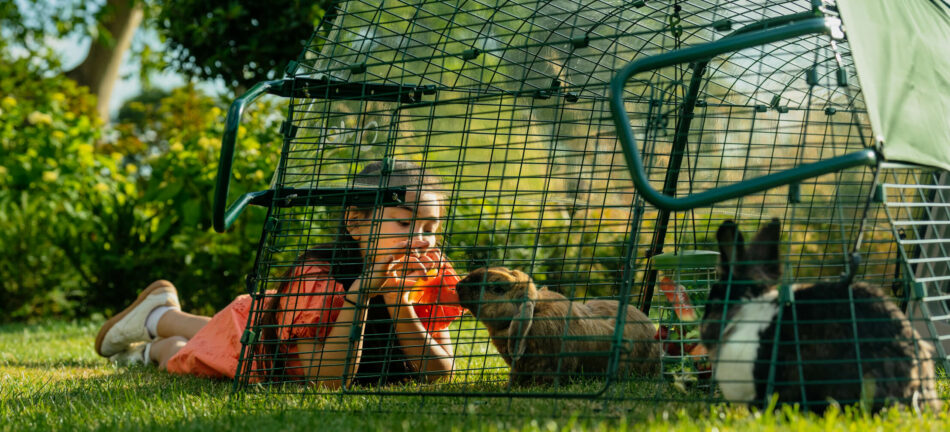
How hot is too hot?
First, it’s important to know when the temperature is simply too dangerous for your rabbits and guinea pigs to be outdoors. The answer of how hot is too hot is subjective to several factors, like:
- Your rabbit or guinea pig’s age and breed
- The ambient temperature vs “real feel” temperature (factoring in humidity)
- The amount of shade available
- How long the temperature will be elevated
As a general rule, you should watch for signs of discomfort from the heat in your rabbits and guinea pigs in temperatures above 85°F. Signs of heat stress in rabbits and guinea pigs include:
- Rapid or shallow breathing
- Open mouth breathing (panting)
- Drooling
- Lethargy
If left untreated, heat stress can quickly progress into heatstroke. Once your rabbit or guinea pig experiences heatstroke, there may be irreparable damage to their internal organs. Signs of heatstroke include those of heat stress, in addition to loss of consciousness or convulsions. If you think your rabbit or guinea pig is suffering from heatstroke, call your veterinarian right away.
How to keep your rabbits and guinea pigs cool
Thankfully, there are several ways to help keep your rabbits and guinea pigs cool in the summertime heat. These rabbit and guinea pig summer safety measures will help protect your pets from the heat, and allow them to spend more time outdoors.
An insulated hutch
Insulated rabbit and guinea pig hutches are the first line of defense against the heat. The Eglu Go Rabbit and Guinea Pig Hutch is twin-wall insulated with vents to provide airflow — which helps keep the hutch cooler than the ambient temperature. Choose a shady spot for your pets’ hutch to help it stay even cooler. When the temperatures really climb, add frozen water bottles inside of the hutch. Your pets will lay on them to cool off, and it will help to bring the interior temperature down even further.
Provide plenty of shade
Your rabbits and guinea pigs’ run should be shady to keep harmful UV rays and blistering heat off of your pets. Solid outdoor run covers keep the sun out, so that your rabbits and guinea pigs can cool down. Place water in the shaded areas to prevent algae growth, and to keep the temperature cooler. And, as with the hutch, add frozen water bottles around your pets’ shaded run to provide extra cooling relief.
Offer cooling hors d’oeuvres
Preparing frozen treats for your rabbits and guinea pigs can go a long way in keeping them cool. Here are some ideas for rabbit and guinea pig-friendly frozen treats:
- Fruit like bananas or strawberries
- Vegetables like green beans, corn, spinach, or broccoli
- Homemade frozen molds or popsicles (with an applewood chew for a stick, or no stick) made from blended fruits and veggies
Add the frozen treats to a Caddi Rabbit and Guinea Pig Treat Holder to keep them fresh for longer, and hang it in a shady part of their run. You can also add ice cubes to your rabbits and guinea pigs’ water bottle to keep it at a palatable temperature.
There are ther refreshing treats that will help your rabbits and guinea pigs stay cool. These aren’t frozen, but they’ll help hydrate your pet, and when kept in the fridge, still provide a cooling effect.
- Apple slices
- Berries
- Lettuces
- Watermelon
Other heat-hampering techniques
There are a few other supplemental methods you can use to help beat the heat. Some of these include:
- Use a patio misting system around the top perimeter of your rabbits or guinea pigs’ run. Turn it on, or have an irrigation timer set for it to be on during the hottest part of the day.
- Install a large fan just outside of the run, or in the top corner of a rabbit or guinea pig walk in run. Make sure that your pets can’t reach any power cords or moving parts of the fan.
Use a combination of both of these for the strongest effect.
What to do when it’s too hot
Depending on where you live, your rabbit or guinea pig’s age and breed, and overall health condition, there may be times where staying outside is just too dangerous. These conditions are most likely to occur during a heatwave, or in areas that experience high humidity alongside soaring summer temperatures.
If you need to move your rabbit or guinea pig to cooler temperatures, try to keep them outdoors if possible. A well ventilated garage, barn, or shed may be enough to keep their setup at a more comfortable temperature.
When shadier or cooler options just aren’t possible, you will need to bring your rabbits or guinea pigs inside. This shouldn’t be done lightly, as rabbits and guinea pigs that live outdoors year round are accustomed to being in fluctuating temperatures. Bringing them into a stable environment will acclimate them to this type of temperature and they will need to remain indoors until the outside temperature is consistently lower.
It’s common for guinea pigs to be housed indoors, and placed outside for playtime. For these pets, outside visits should be limited to early morning and late evening hours during the summer to avoid the hottest part of the day. This is also true for rabbits housed indoors.
Omlet and your small pets
Summer isn’t without its challenges, but that doesn’t mean you shouldn’t be able to enjoy it with your pets. With our rabbit and guinea pig hutches, large outdoor rabbit and guinea pig runs, and outdoor run covers, you can provide plenty of shaded support for your pets throughout the summer. With an Omlet rabbit or guinea pig setup, you can enjoy a frozen treat together with your rabbits or guinea pigs, and rest easy knowing they’re being supported all summer long.
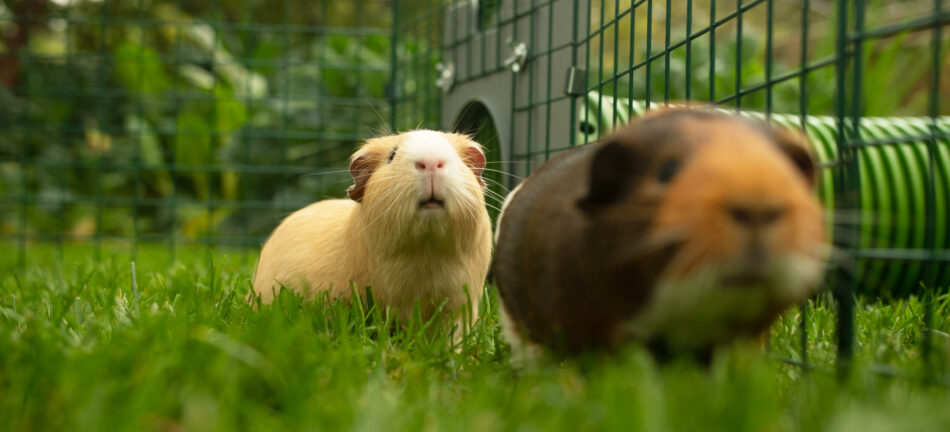

This entry was posted in Guinea Pigs
Looking for some inspiration for playtime with your small pets? There are several games you can play with your rabbits and guinea pigs that will be to the delight of everyone involved. From mazes to hide-and-seek, here are some pastimes that are sure to please your pets the next time you play.
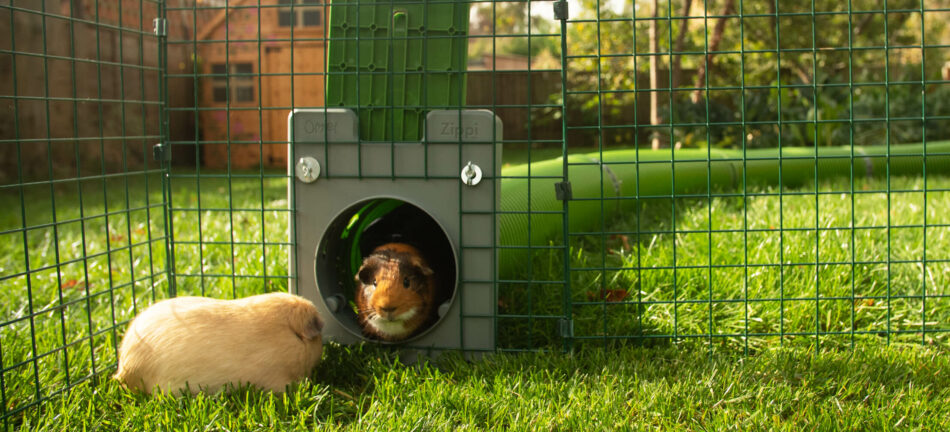
The importance of play
Playing with your rabbits and guinea pigs builds their trust and confidence, which in turn helps you build a more meaningful and lasting bond with them. It’s amazing to see shy or timid pets come out of their metaphorical shells through playing with their humans. Being more active is good for their minds and bodies, and is one of the best ways to encourage your small pet to be more outgoing and physically fit. Through dedicated playtime, you’ll be able to forge an unbreakable bond between you and your rabbits or guinea pigs.
It’s also important to remember that rabbits and guinea pigs are prey animals by nature, so surprises, sudden movements, or loud noises can startle them easily. All of the games that you play with your small pets should be in a calm atmosphere, and with lots of treats to offer as tokens of encouragement and as rewards for their efforts.
Species-specific
Rabbits and guinea pigs differ in size and stature, so they each have their own set of skills that can be tapped into during play. For example, rabbits have long, powerful legs, so jumping over the sides of a homemade maze to fast-forward to the treat at the end is entirely within their realm of possibility. For the following activities, we will offer suggestions to modify each game based on the size and species of your pet.
Prepare a place to play
The best place to play with your rabbits and guinea pigs is in a safe and enclosed space. Outdoor rabbit and guinea pig runs are perfect for spending time with your pets during playtime. The enclosed space will keep them contained and comfortable, and gives you plenty of space to set up your games. Alternative play places are safe spaces inside your home — just make sure that the room you’re playing with your pets in is rabbit and guinea pig-proof.
Bowling
This game is more fitting for bunnies, but some guinea pigs may delight in barrelling objects over. Set up small bowling pins, like indoor sets designed for toddlers, and let your bunnies nose-boop them over. Reward your pets’ efforts with a treat before setting the pins back up for the next round.
Guinea pig modification: in relation to guinea pigs, even toy bowling pins may seem tall and intimidating — try setting up empty toilet paper tubes instead.
Magic cups
Show your rabbits or guinea pigs that you’re hiding a treat under an overturned plastic cup. Add one or two more overturned cups with nothing under them, then slide them around before allowing your pet to sniff out the hidden treat. Fresh herbs or other fragrant treats are perfect for this game.
Fetch
Think fetch is just for dogs? Think again — some rabbits and guinea pigs enjoy carrying small objects in their mouths. Try tossing small toys like balls, applewood chews, or pieces of cardboard for this game. To start out, toss the object just a few inches in front of your rabbit or guinea pig. If they pick it up, praise them, and offer a treat. Once they’re consistently picking up their toy, toss it farther out each time, and encourage them to bring it back to you.
Hide and seek
Rabbits and guinea pigs are curious by nature, so enticing them with some mystery will pique their interest. Lay on the floor and place your face in your hands. Your rabbit or guinea pig will come to investigate. Be careful not to startle your pet as you emerge, and be sure to offer them a treat for their cleverness.
Rabbit modification: hide under a soft blanket and call your rabbit. Bunnies love to burrow, so your rabbit will be thrilled at the prospect of digging in order to find you.
Maze running
Create mazes from cardboard boxes, building blocks, or other household objects with a treat placed at the end. Make sure that mazes are always placed at ground level, and that there are no small gaps or spaces for your pets’ feet to get caught in.
Rabbit modification: construct a maze from Zippi Rabbit Tunnels for the ultimate, reusable maze that your rabbits won’t hop out of.
Omlet and your rabbits and guinea pigs
From the rabbit or guinea pig hutch to outdoor runs and playpens, we’ve worked to create the perfect atmosphere for owners to spend quality time with their small pets. Design your own playground with Zippi Rabbit and Guinea Pig Tunnels, and add rabbit and guinea pig platforms to help your pets meet you on a whole new level. With Omlet, playtime isn’t just possible — it’s the pinnacle of quality time spent with your rabbits and guinea pigs.
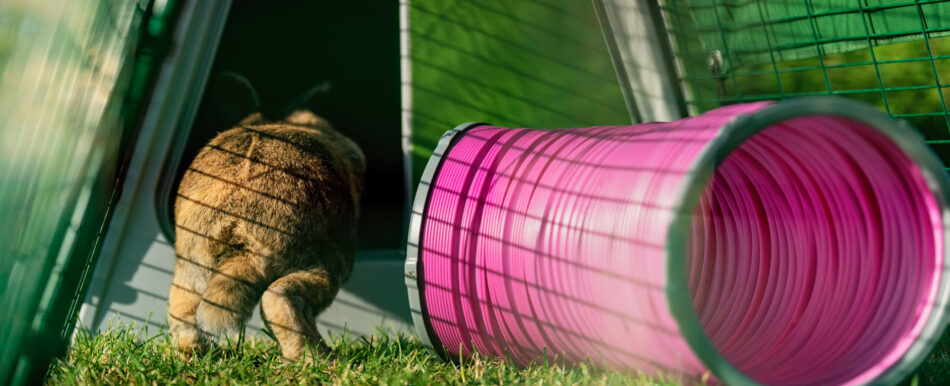

This entry was posted in Guinea Pigs
Exercise for rabbits and guinea pigs is important for their overall wellbeing, but it’s also a unique opportunity for you to bond and play with them. From playtime to training sessions, there are several ways to spend quality time with your rabbits and guinea pigs while benefiting their physical and mental health. Discover how much exercise your pets need, how to keep them fit, and how to build a bond through boredom busting activities with your rabbits and cavies.
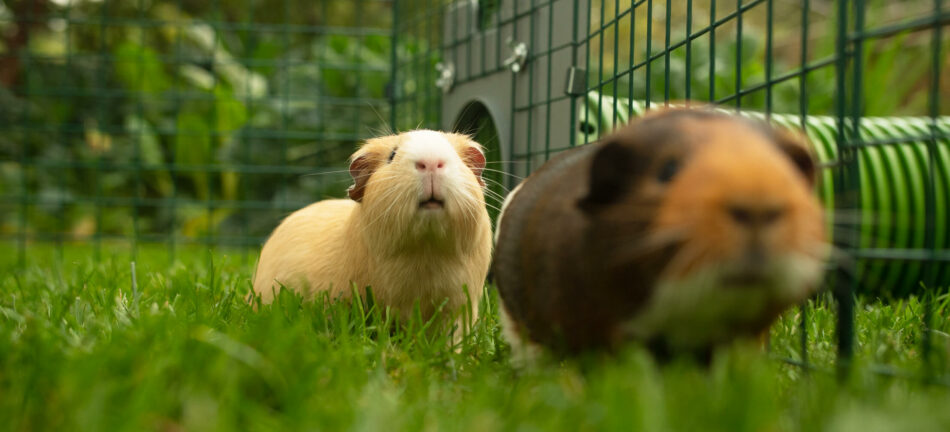
How much exercise do rabbits and guinea pigs need?
Rabbits and guinea pigs need to be able to exercise on their own, as well as doing activities with their owners. The amount of exercise needed for each pet varies and is dependent upon their genetics, diet, and environment. This means that these pets need spacious outdoor rabbit runs or guinea pig playpens to ensure they have ample space to run, hop, stretch, and explore.
Wild rabbits and guinea pigs are constantly on the move for their survival. This continuous need to move keeps them fit and spry — which are traits not always seen in their domesticated counterparts. While our backyard rabbits and guinea pigs may be distantly related to their ever-moving ancestors, their body compositions are still very similar. All rabbits have long, powerful hind legs, and guinea pigs are all potato-shaped with short legs and necks.
Guinea pigs are especially prone to being overweight, which puts strain on their small legs and joints. But rabbits aren’t immune to issues caused by lack of exercise — they too can become overweight, and are also prone to boredom if they aren’t properly stimulated. Bored bunnies can become depressed or develop destructive habits. By giving bunnies and cavies plenty of outdoor space, you’ll help them get enough exercise to keep them healthy and happy.
Encouraging your rabbits and guinea pigs to exercise
Fostering your pets’ natural behaviors is one of the best ways to encourage them to exercise. Because of their anatomy and natural instincts, rabbits need large, outdoor spaces to fulfill their need to run, burrow, and scratch. Zippi Rabbit Tunnels simulate burrows in the wild that rabbits run through, which will encourage your bunnies to explore and play. And while guinea pigs might not dig their own tunnels in the wild, they will happily use burrows dug by other animals — or in the case of domesticated guinea pigs, those provided by humans.
Guinea pigs can’t stand on their hind legs like rabbits can, so they appreciate a higher vantage point from which to view their world. Zippi Guinea Pig Platforms offer your cavies an elevated place to explore, and a shady, secluded space to hide beneath. The attached ramps encourage your guinea pigs to carry their weight at an incline, which strengthens their muscles and helps them maintain their figure.
Exercises you can do with your rabbits and guinea pigs
There are several ways to interact with your rabbits or guinea pigs while encouraging them to exercise. Some ideas include:
These are all fun ways to keep your pets fit both physically and mentally, while also providing you with a unique opportunity to build trust and confidence with them. Aim to incorporate half an hour of playtime with your bunnies and cavies once a day to help keep your pets bodies and minds stimulated. Playing with them doesn’t have to be robust, so any amount of interaction or movement that they would otherwise not be experiencing will build both a confident mind and strong muscles.
Exercises to avoid with your rabbits and guinea pigs
There is some equipment marketed for rabbits and guinea pigs that should be avoided, and some activities they shouldn’t participate in. These include:
- Exercise wheels or balls (similar to those for hamsters) marketed for rabbits or guinea pigs
- Leashes and harnesses
- Walks around your neighborhood
While it might be tempting to take your rabbits or guinea pigs for walks on a harness, the vast majority of small pets find harnesses uncomfortable and alarming, so it’s best to play with your bunnies and cavies within the safety of playpens designed for them, or in a pet-proof area of your home. Rabbits and guinea pigs are prey animals, and as such can startle and bolt easily with sudden sights and sounds — the strain from them spooking on a harness can cause severe damage to their necks, backs, and legs.
Omlet and your rabbits and guinea pigs
From guinea pig playpens and outdoor rabbit runs, we’ve created safe and smart enclosures that allow your pets the freedom to move and explore. These spacious options also make it possible for you to join them in their endeavors — putting you front and center in their lives. Watch your rabbits and guinea pigs explore through Zippi Tunnels, climb and meet you face-to-face with Zippi Platforms, and witness them experiencing the joy of fresh grass with mobile rabbit and guinea pig hutches. You, your pet, and Omlet are a winning combination for years of health and happiness to come.
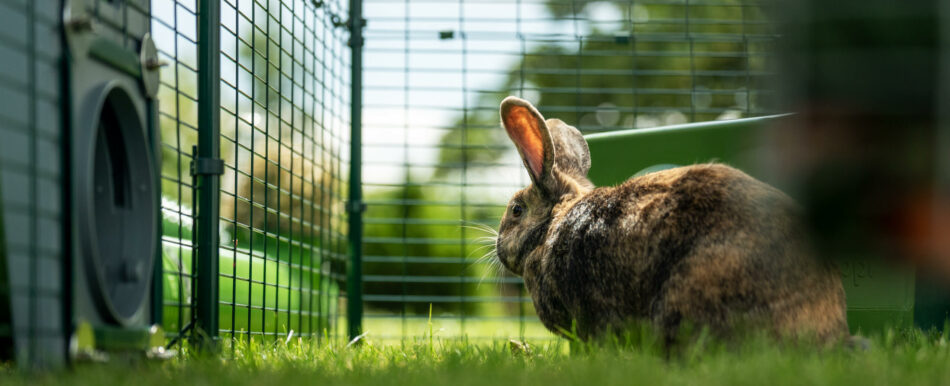

This entry was posted in Guinea Pigs
Spending time with your rabbits or guinea pigs is a great way to grow your bond with them, especially when there are toys involved. DIY toys for rabbits and guinea pigs are easy to make with materials that are probably already in your home. And these toys aren’t just for your pets — you’ll find that watching and interacting with your rabbits or guinea pigs through toys is both engaging and entertaining. Discover how making some of your rabbits and guinea pigs toys can be fun and rewarding.
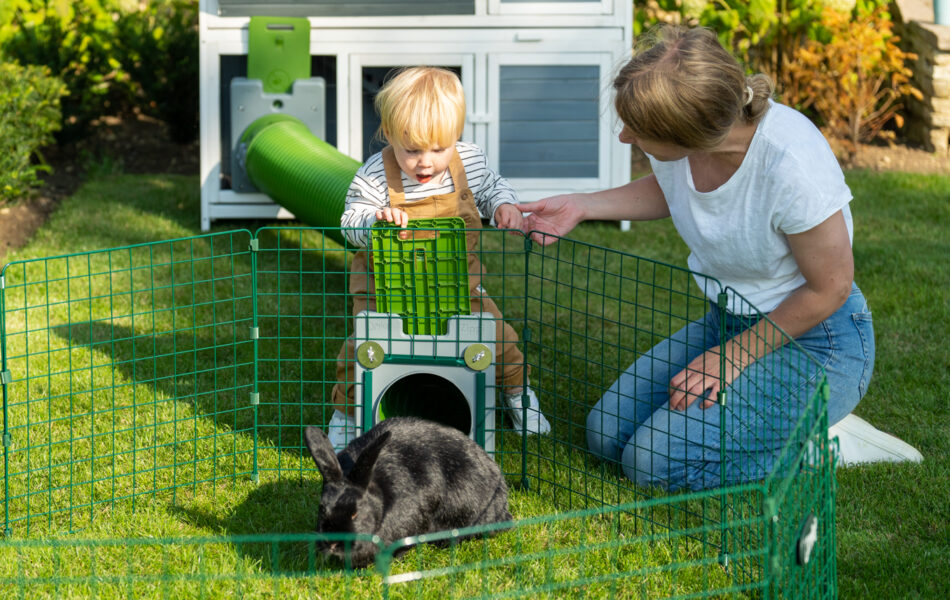
Why do rabbits and guinea pigs need toys?
First, it’s important to understand why rabbits and guinea pigs need toys. Think back to your childhood — you likely played with toys as a means of entertainment, but also to aid in the development and growth of your cognitive skills. The same is true for rabbits and guinea pigs.
Rabbits and guinea pigs are able to keep themselves active and entertained with toys, as well as grow their critical thinking and problem solving skills. These pets may be small, but they’re smart and enjoy objects to chew, toss, chase, or cuddle up with. There are several types of toys for rabbits and guinea pigs that can be purchased, but there are many that you can make at home.
How to play with your rabbits and guinea pigs
Playtimes are some of the best times with your rabbits and guinea pigs. Owners that play with their pets get to experience their individual personalities, and build a bond with them that lasts a lifetime. Through play, your pets will learn to trust you, and you’ll be able to identify their unique body language and needs.
Start by sitting on the floor or the ground with your rabbits or guinea pigs. Offering treats will help entice them to approach you if they are not already comfortable doing so. Introduce new toys one at a time so your pets aren’t overwhelmed. Show them their toy, maybe offering some movement if your pet is comfortable with it. Hang or place the toy in front of your pet, and watch them explore this new offering.
Some rabbits and guinea pigs can be taught to fetch small toys, while some are more interested in the aspect of chasing. Play around with different ways of interacting with your pets, like with Zippi Rabbit and Guinea Pig platforms to help you both see eye-to-eye.
Types of DIY toys for rabbits and guinea pigs
The most common types of toys for rabbits and guinea pigs include:
- Chews
- Activity toys
- Tunnels
- Forage boxes
- Hideouts
You can make your own versions of many of these toys using household objects, or with a short trip to your local hardware store. It’s important to remember to choose non-toxic materials for your pets’ toys. Never use treated lumber or paint for your rabbits’ or guinea pigs’ toys, and make sure that any cardboard or fabric is removed if your pets begin to nibble on them. And, it’s always a good idea to supervise your pets while they’re playing with their toys — especially if they are inclined or able to eat them.
DIY rabbit and guinea pig chews
Most rabbit and guinea pig chews are made from apple wood or compressed timothy hay, or a combination of the two. There aren’t many substitutes for apple wood chews for rabbits and guinea pigs, as they are the safest variety. But, by purchasing bulk apple wood sticks and timothy hay, you can craft your own chew toys by wrapping the sticks in strands of hay. Cut them to various lengths, and create different shapes for variety. Sisal rope can also be used to wrap apple chews and hay together — just remember to remove the toy as soon as the rope becomes frayed or gnawed.
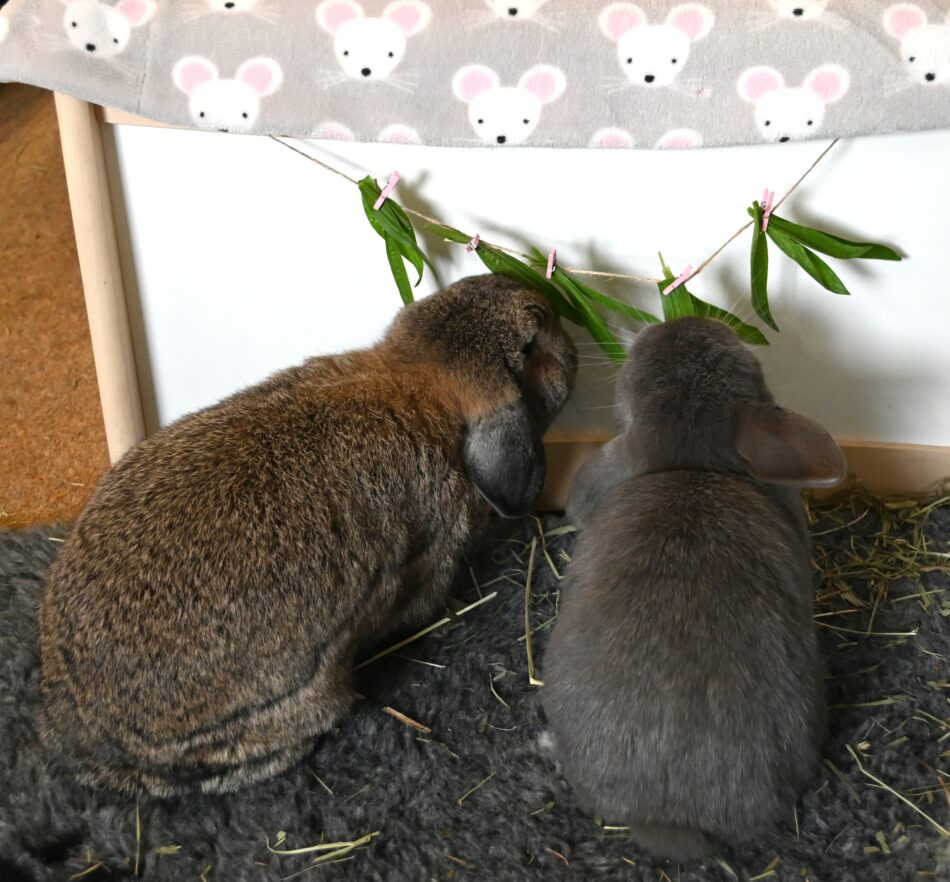
DIY rabbit and guinea pig activity toys
Activity toys are those that hang from your rabbit and guinea pig run. They’re designed to encourage your rabbits and guinea pigs to stretch, nudge, or tug. Most of these toys are made from apple wood and sisal rope, which are safe options for your pet. Experiment by making spiral or branch shapes, or by threading alternating pieces of apple wood with other edible treats like rabbit and guinea pig-safe fruit or veggies.
You can also hang a Caddi rabbit and guinea pig treat holder in their run to encourage the same activity. The Caddi reduces waste, and has lots of room for your pets’ favorite treats.
DIY rabbit and guinea pig tunnels
Rabbit and guinea pig play tunnels that are made for small pets will hold up better than DIY alternatives. Some owners make tunnels from drainage tubing, but the small holes designed to release water pose a risk to your pets’ feet. A Zippi Rabbit and Guinea Pig Tunnel System is the best investment when it comes to fostering natural burrowing behaviors in both pets. The safest way to create temporary tunnels for your rabbits and guinea pigs in the meantime is to use boxes connected end-to-end.
DIY rabbit and guinea pig forage boxes
A shallow storage tote or livestock feed bin makes an excellent base for a forage box for your rabbits and guinea pigs. Pour 1-2 inches of sand or top soil into the container, or add scraps of recycled cardboard or paper to create a substrate for your pets to dig through. Rabbits in particular will appreciate the opportunity to dig in soil. Once you’ve added a layer of substrate, toss small toys, chews or treats into the box and watch your pet forage for their findings.
DIY rabbit and guinea pig hideouts
There are several ways to create hideouts for your rabbits and guinea pigs. As prey animals, they both appreciate the opportunity to hide when they’re tired, overwhelmed, or during games of chase with each other. Rabbit and Guinea Pig Shelters are specially designed to create a safe haven for your small pets, and are the best option to be kept with their rabbit or guinea pig hutch and run. But, short play sessions, or additional options can be created with cardboard boxes, overturned plastic plant containers with an entrance cut into them, or with other creative alternatives. Just remember not to use treated materials, and be aware that DIY options are not weatherproof, and should not serve as a substitute for their hutch.
Omlet and your pets
From rabbit and guinea pig hutches, to outdoor rabbit and guinea pig runs , discover how your pets encounter their world when you’re able to take an active role in it. Explore with them, encourage them, and most of all, enjoy them on a daily basis when you have rabbit and guinea pig products that have been designed to bring you closer than ever.
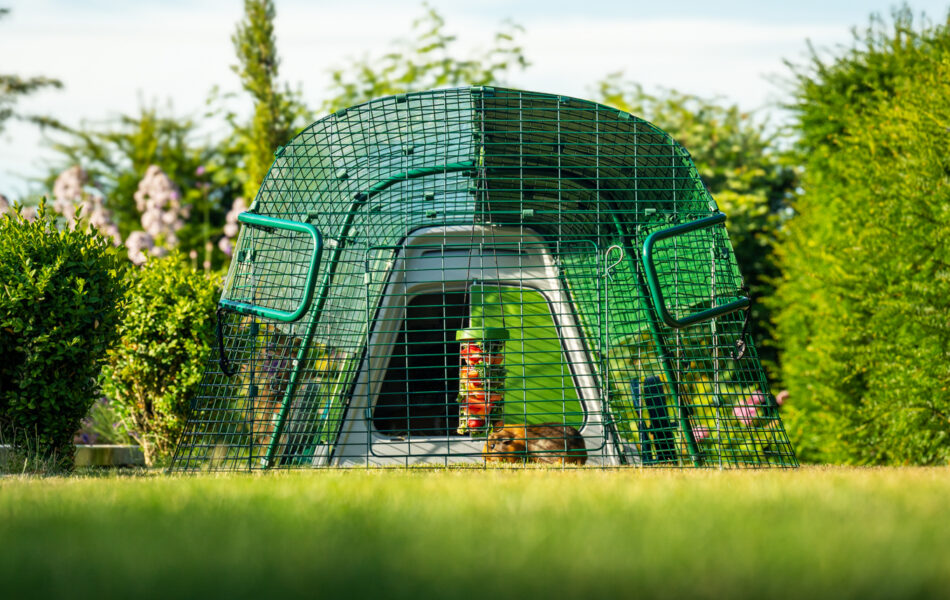

This entry was posted in Guinea Pigs
Thinking about adding a small pet to your family? Despite having different needs, rabbits and guinea pigs require many of the same accommodations, so whichever you’re considering adding to your family, your shopping list will look similar. From hutches and runs, to play and feed, we’ve got the ultimate rabbit and guinea pig checklist for you to tick off before you bring your fluffy new friends home.
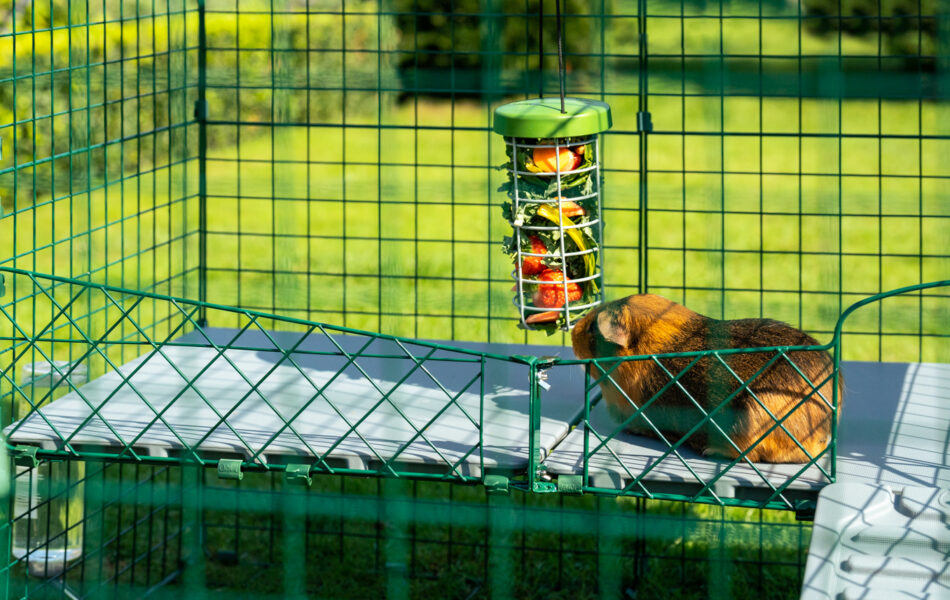
Caring for rabbits and guinea pigs
Rabbits and guinea pigs both make wonderfully rewarding family pets. They can be housed indoors or outdoors in suitable climates; either way they need plenty of room to roam and certain equipment to stay safe, happy and healthy. With the appropriate setup and care, rabbits and guinea pigs can live up to 8-10 years.
Rabbits and guinea pigs have different nutritional needs and communication methods, so should be kept separately. They’re both social animals however, and need the companionship of their own kind. So, when planning your pets’ future home, make sure you can provide room and care for at least two of either.
Hutches
Traditionally, rabbit and guinea pig hutches have been made of wood, but this poses a few problems. Both rabbits and guinea pigs have teeth that grow continuously. They need to gnaw almost constantly in order to keep their incisors from over growing, which leads to serious health problems. Wooden hutches are tempting to chew on, and treated lumber can be toxic to pets. They’re also drafty, inadequate in more extreme weather, and absorb moisture, ammonia and odors, so can become unhygienic and need replacing in no time at all.
Eglu Go Rabbit Hutches and Eglu Go Guinea Pig Hutches are designed to give your small pets the safety and comfort they need and deserve. They are both also designed to be used in conjunction with fixed, steel mesh runs, giving your rabbits or guinea pigs free access to an outdoor space (more on this below.)
- Made of pet-safe, strong, durable plastic
- Twin insulated for optimal internal temperatures
- Draft-free ventilation
- Easy to clean in a matter of minutes
- Predator proof design
- Built to last a lifetime
Starting out with a durable, easy clean rabbit or guinea pig hutch is an investment you will soon recoup, which will set you and your pets up for success from the first day.
Bedding
The bedding you use inside of your rabbits’ or guinea pigs’ hutch should be natural and absorbent. Typical bedding options include:
- Pine shavings or pellets
- Aspen shavings
- Recycled paper (this resembles loose cotton)
- Straw
Breeds of rabbits with long hair like Lionheads or Angoras need recycled paper or pine pellets as bedding – straw and shavings will get tangled in their coats. Similarly, breeds of guinea pigs with long hair like Peruvians or Shelties should not be kept on shavings or straw bedding.
Outdoor space
Rabbits and guinea pigs need plenty of space outside their hutch to stretch their legs and explore, which they should ideally have constant, secure access to. Rabbits in particular have lots of energy, so a spacious outdoor rabbit run is essential to helping them stay healthy and happy.
If you’re short on outdoor space, the Omlet Zippi Tunnel System is a great way to recreate their natural environment and let them zoom when the mood takes them, as it lets you connect their hutch to additional enclosures in different areas, as a burrow would. Guinea pigs also need an outdoor guinea pig run to stay fit and can also benefit from a tunnel system, as they can be prone to obesity and boredom if they don’t have enough space to exercise.
Omlet’s rabbit and guinea pig runs have attached floor panels to prevent digging out, which is an issue in particular with female rabbits, but is also necessary to prevent predators digging in.
Constructed of weatherproof, heavy-duty steel weld mesh, Omlet runs have a modular design that lets you expand your run when you like, making them a future proof choice.
Enriching their area
Part of the joy of having rabbits or guinea pigs is watching them play. The best rabbit and guinea pig toys are those that encourage their natural behaviors. Rabbit and guinea pig run accessories, like shelters, play tunnels and platforms make perfect places for your pets to stretch their legs, find a shady spot for a snooze, or just hunker down for some quiet time. Since both rabbits and guinea pigs are prey animals, they’re naturally nervous and always on high-alert for potential predators. Shelters and tunnels they can retreat into quickly if they perceive danger give them a sense of security, so placing these throughout the run will help your rabbits or guinea pigs feel much more at ease.
Food
Both rabbits and guinea pigs should be fed high quality pellets as per the instructions on the pack. However, unlike rabbits, guinea pigs can’t manufacture their own vitamin C, so commercially available guinea pig pellets should be fortified with this essential nutrient. Their different dietary needs are one of the main reasons rabbits and guinea pigs should be kept separately.
An essential part of their wellbeing is plenty of timothy hay, which both rabbits and guinea pigs need free-choice access to around the clock. This keeps their digestive system working as it should, but also helps keep their teeth trimmed. Timothy hay won’t cause rabbits or guinea pigs to become overweight, so it’s safe (and necessary) for it to be available at all times.
Both bunnies and cavies will most likely enjoy the odd fresh crunchy treat. Leafy greens, chunks of raw broccoli or cabbage, fresh herbs and small amounts of some fruits will have them hopping over for a nibble. Keep these treats off the ground with a Caddi Rabbit and Guinea Pig Treat Holder to keep them fresher for longer and discourage pests.
Omlet and your rabbits and guinea pigs
Keeping rabbits and guinea pigs is a rewarding experience for all ages, but despite their diminutive size, these cuties need daily care and attention. Our Eglu Go Rabbit and Guinea Pig Hutches are designed to make providing your small pets with a hygienic, comfortable home a breeze. With cleaning done and dusted in a matter of minutes, you can spend your time enjoying their quirky characters, sociable natures and natural curiosity.
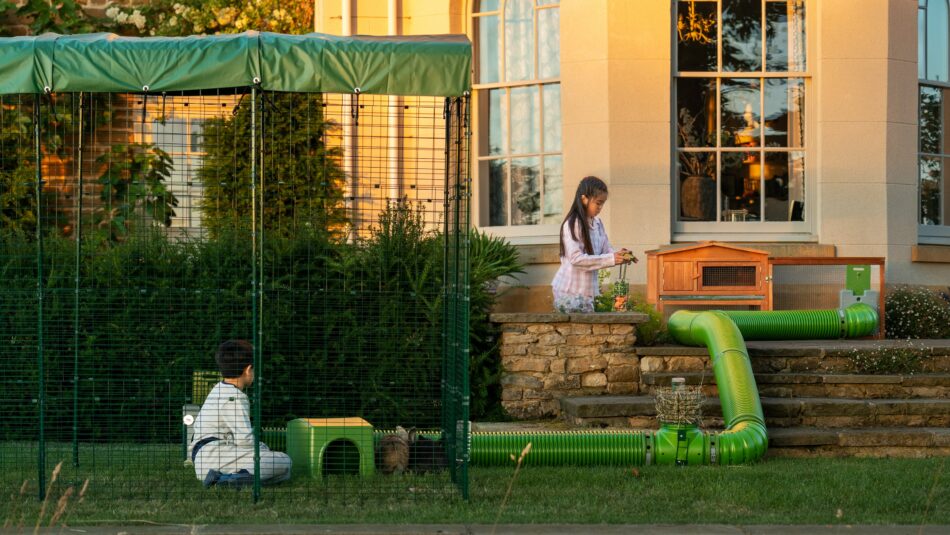

This entry was posted in Guinea Pigs
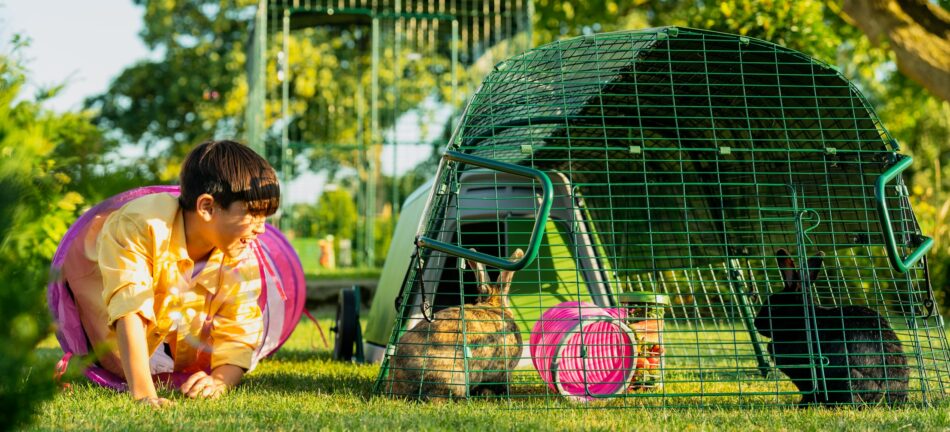
Wondering how to pick the right hutch for your rabbit or guinea pig? It’s easy to get bogged down by all of the choices available for potential and current cavy or rabbit owners. We’ll help you decide how to pick the right home for your small pets, and how to help them enjoy it to the fullest.
Picking the perfect hutch
There are some important factors to consider when picking the right hutch for your rabbit or guinea pig. The materials, size, and placement of their home will greatly influence how you care for your furry friends, so need careful consideration. With these guidelines, you’ll be able to select a hutch that fits all of your needs.
Indoor or outdoor
Rabbits and guinea pigs can be kept indoors, but they are just as happy outdoors in an insulated hutch with a spacious run to give them plenty of room to run and play. If left to roam the house, rabbits and guinea pigs will happily find cords, wires, baseboards, or other items to chew on. And while they can be litter box trained, you’ll likely be sweeping up fecal pellets on an hourly basis. An outdoor setup makes cleanup a breeze, and you won’t need to worry about your pets nibbling on something they shouldn’t.
Housing your rabbits or guinea pigs outdoors year round is not only possible, but made easy with insulated hutches. Rabbit and guinea pig hutch weather protection can be added as an additional layer of insulation during frigid temperatures, and run covers provide shade and protection from the rain.
It should be noted that not all rabbit breeds and guinea pig breeds will thrive outdoors — especially in extreme climates. Guinea pigs in particular are suited to a milder climate, whereas many rabbit breeds do well outdoors. However, bringing them in and out is not good practice, as they will acclimatize to one or the other and won’t cope well with sudden changes in temperature. Breeds that require careful observation when housed outdoors:
Rabbits
Guinea Pigs
Consider size
Rabbits and guinea pigs are very social animals, and need friends of their own kind. While you can keep rabbits and guinea pigs together successfully, they each have different dietary needs and require their own space, so it’s best to start out with one species at a time, and always in pairs. Spayed and neutered males and females are good pairings, as are same-sex pairings (though rabbits should always be spayed or neutered in same-sex pairings to avoid territorial scuffles).
A home for your rabbits and guinea pigs is much more than just a hutch for shelter and sleeping — they should also have a run large enough for them to run and play in. As with other pets, both rabbits and guinea pigs benefit from the most space possible. Providing extra space through Zippi Tunnel Systems and Zippi Play Pens gives you an opportunity to customize your pets’ setup and offer them plenty of space outside of their hutch without sacrificing safety.
Give yourself some space
Don’t forget to factor in spending time with your rabbits or guinea pigs when choosing their hutch. Give yourself plenty of space to access their food and water for easy refills, and space in the run to spend time with them. If crawling or reaching into a run won’t be feasible for you, consider adding a rabbit and guinea pig playpen to their setup for easy access and quality time together. A Walk In Run is also a great addition if you have space, as it makes spending time with your small pets particularly comfortable, and gives easy access for cleaning or for switching their set up around for variety in their play and exercise.
Materials matter
Traditionally, rabbit and guinea pig hutches have been made from wood. It’s a readily available, inexpensive material that gets the job done. But, over time wood will rot, shingled roofs will need repairing or replacing, and hardware cloth will pull away from wood staples. And, wood is a very enticing material for rabbits and guinea pigs to gnaw on, which poses a risk not only to the structural integrity of the hutch, but to your pets’ health as well. Treated wood can be toxic when ingested, and splinters or large pieces of wood can cause obstructions in your pets’ digestive tract. Wood also absorbs ammonia from urine, and is difficult to keep hygienic, even with lining such as card or paper, as this too will soak through and be shredded by busy paws.
Plastic rabbit and guinea pig hutches don’t rot, warp, need re-roofing, or pose a gnawing risk to your pets. They’re weather resistant, don’t absorb moisture or odors, and can last a lifetime. And, instead of hardware cloth held in place with staples, the attached runs of Omlet’s rabbit and guinea pig hutches are made of heavy duty welded steel mesh that are held in place with strong, weather resistant clips. The Eglu Go Rabbit and Guinea Pig Hutch is easy to clean, and can be moved with ease with the addition of optional wheels and handles. Over time, this makes opting for an Eglu Go a great investment – financially but also in terms of time. With a slide out try you can simply wipe clean, you will be able to keep their hutch shipshape in a matter of minutes.
Accessorize their home
Once you’ve picked out your rabbits’ or guinea pigs’ hutch and run, it’s time to accessorize. Elements like treat holders, Zippi Platforms, and shelters and play tunnels are all ways to keep your small pets entertained, engaged, and enriched in their environment. They also help you interact with your pets on a whole new level, and build the bonds between you that last a lifetime.
Omlet and your rabbits and guinea pigs
We didn’t want ordinary hutches for extraordinary pets — so we created rabbit and guinea pig products that defy the norm. Our products also aim to bring you closer than ever to these animals that have captured the hearts of so many. From easy to clean hutches, spacious outdoor runs, and the one of a kind Zippi tunnel system, you’ll be amazed at how fun and intuitive it can be to interact with your rabbits and guinea pigs.
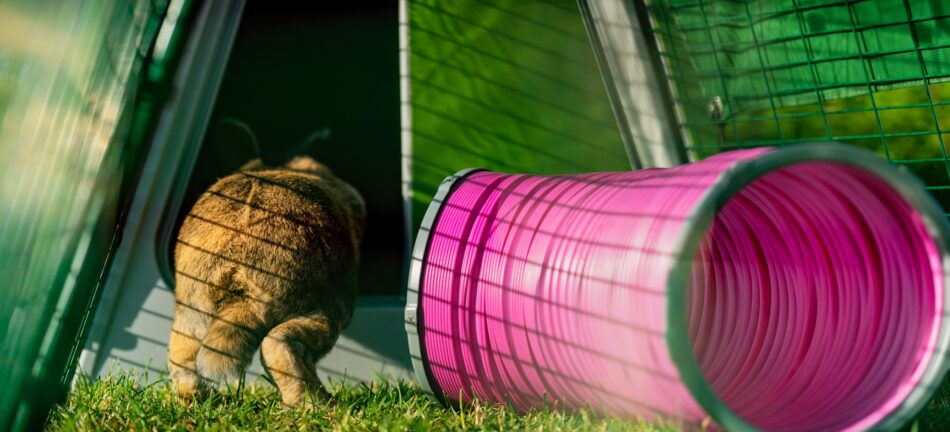

This entry was posted in Rabbits
“We do a running commentary of what we think they’re saying – we have a laugh as a family.”
Ready to make room for rabbits? Shell Mills takes us through a day caring for these adorable yet naturally anxious animals.
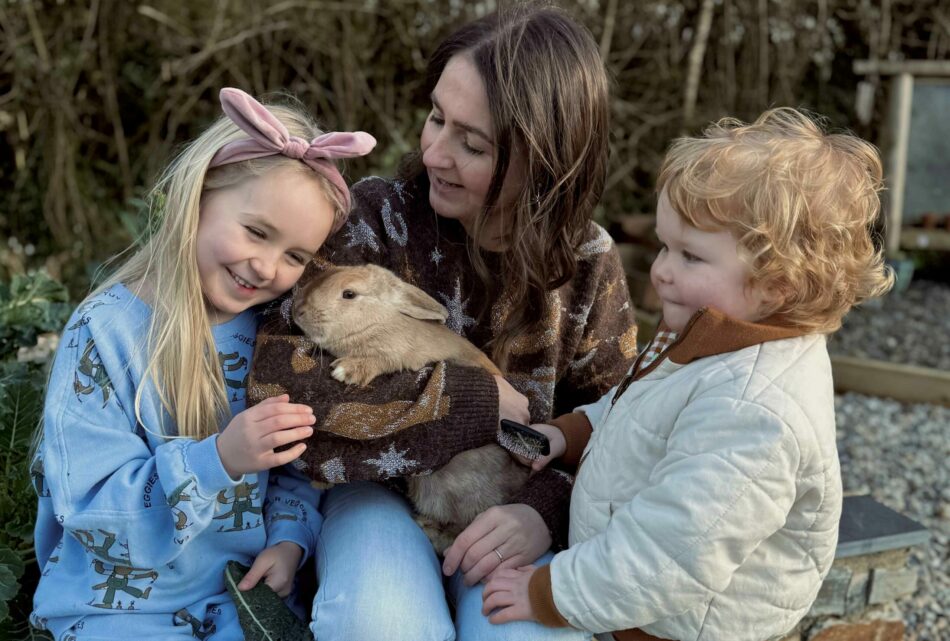
In a cat and dog world, what made you pick rabbits as pets?
Well, we have got a dog actually, but my first pets were rabbits and I always loved them. My husband and I had a dwarf lop together too, before we had kids. Then from about the age of five, our daughter, Valli began asking for one. We knew it was only a matter of time before we agreed. We thought she was too young – we said she had to be able to be responsible first. We said seven, then the years flew by and suddenly she was seven, so we had to say yes!
I bet she was thrilled! How did you go about getting them?
We made it a surprise – we’d been trying frantically to find some that would be old enough at the right time to tie in with her birthday. We’d researched reputable breeders and sources and we knew our local garden center had some coming, but they arrived when we were on holiday, so we had to get in touch from abroad to reserve ours.
The next step was buying a hutch – but I already knew we would get an Eglu Go. Our local primary school had an Omlet coop for their chickens – and I loved it. I looked online and once I knew Omlet made rabbit hutches, my decision was made. We managed to set them up in their Eglu for her birthday. It’s fantastic. We move their whole set up around and they save us from mowing the lawn! We often talk about chickens too – we might get some down the line!
What did she name them?
Bagel & brioche – after her favorite bread products!
Brilliant. And how does she get on with caring for them? There’s a misconception that rabbits are low maintenance – actually, they need a fair bit of looking after and are very sociable.
Yes, that’s true. Well, we definitely didn’t jump into it – it had been ten years since our dwarf lop and we did a lot of research. It’s better understood now that you shouldn’t have one rabbit – you need to have two, ideally from a young age to help them bond. They need daily attention too – they thrive on contact and are so playful and sociable.
There were other factors we hadn’t considered initially too – yearly vaccines, pet insurance, neutering or spaying – people might think it’s just a rabbit, but they come with responsibility and costs. There are so many extras. Then there’s what to do when you go away – we’re lucky, we have my parents nearby and they help us out.
What advice would you give to prospective rabbit owners?
Well, to do your research and understand their needs. You need to clean them out frequently – the Eglu is a real game changer in that sense. But also, consider all the costs and time you’ll need carefully before you commit.
What are the best bits about having rabbits?
I asked Valli these questions, as I wanted her input and her answer was, they are so cute, and they give the best cuddles! I do think it’s great to teach kids responsibility – how to care for something every day, when it’s sunny and when it’s raining. Vali is great with them and has a routine. She even brings in their water bottle to clean it with a little brush.
I think something you might not think of beforehand is the pleasure of just observing them – we love watching the two of them together. They’re so clever and the way they play together is just lovely. It’ll be wet and chilly, but they love being outside anyway, and they’ll be all cozied up under their run cover, sniffing the air, watching the rain. We do a running commentary of what we think they’re saying – we have a laugh as a family.
Whenever we go out, they come running over. Valli gets inside their run with them – it’s great for that. Not all rabbits enjoy being handled, but ours always have been and they’re so relaxed with it and will sit and cuddle peacefully on your lap. Our dog, Percy was a bit excited when we first got them, but he’s so unbothered now; he’ll potter over and they hop up and then they touch noses through the run!
Ha! That is very sweet. So, what does a typical day caring for the buns look like?
Bagel and Brioche start their day with Valli or Daddy going out to feed them, which means a small amount of pellets, topping up their hay, and giving them fresh water.
They have an attached Omlet run with an extension, so we see them running around throughout the day in the different sections. We just love watching them and seeing their movements, going through the tunnels and jumping on top of things – they love doing that.
Valli and our other children will go out and see them after school, and we go out again later to feed them and top up hay and water, but we don’t shut them in at night. It’s the great thing with the Omlet set up. With the underfloor mesh it’s fox proof, so they can come in and out as they please.
We refresh their bedding regularly and at weekends they come out into their open playpen and the kids go in there with them. That’s when we give their hutch a full, deep clean out. Sometimes they come into the house and explore while we’re doing that.
A few times a week Valli might take them treats from our vegetable garden. This time of year we only have broccoli and kale left, which they love. Then a couple of times a week we move them around the garden for a change of scenery! It’s a nice routine. Valli loves it all and does it happily – apart from sometimes, when it’s absolutely tipping it down! Then I step in and help out. They are her rabbits, but having pets is always a family activity really.
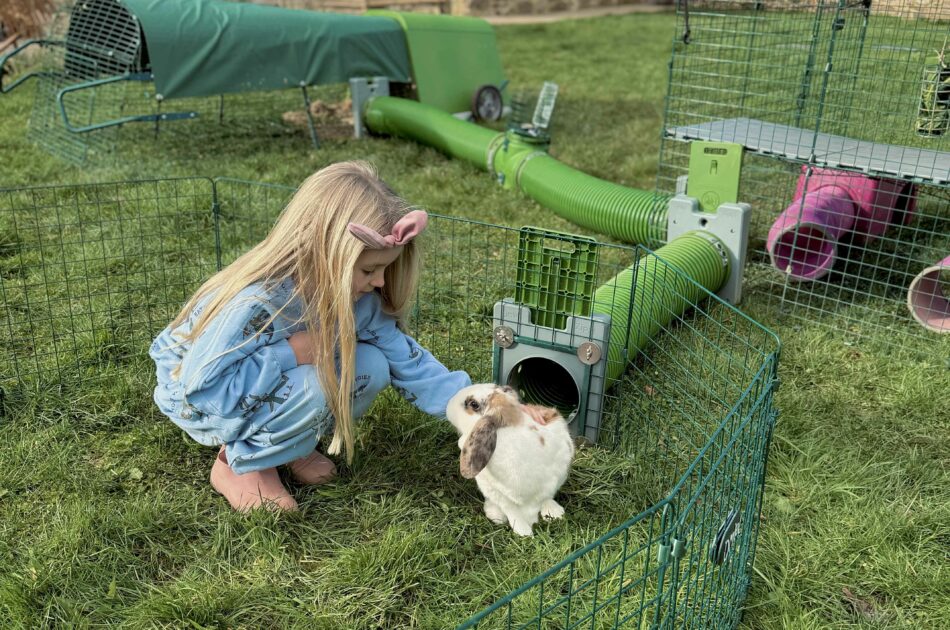

This entry was posted in Interview
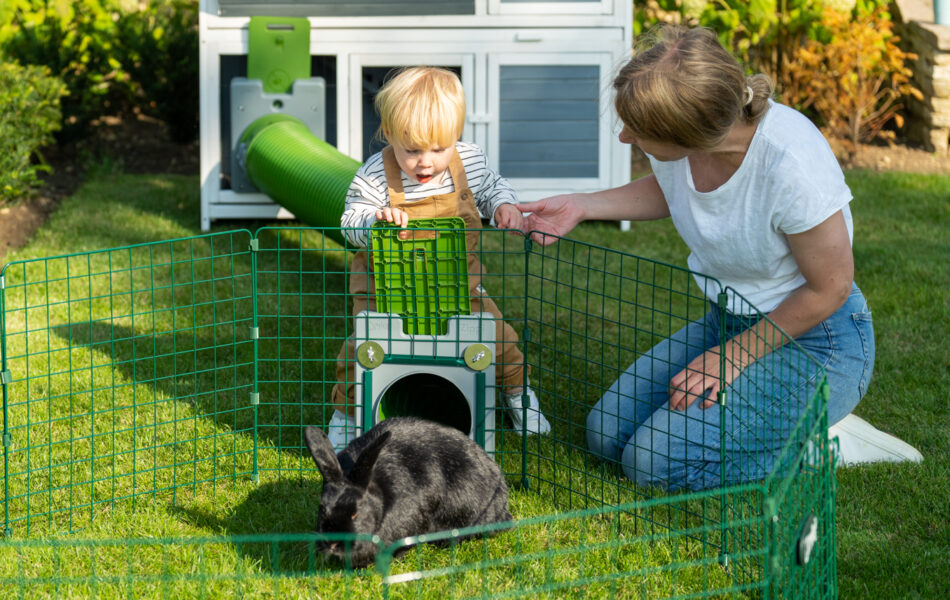
Thinking about adding a rabbit to your family? Rabbits make fun and interesting pets, and with the right setup and routine, they can live a long and happy life, bringing you joy for years to come. But there are a few things to know before getting a rabbit – from how many and what kind, to how they’re housed and what to feed them, here’s everything you need to know before bringing home a bunny.
Rabbits need a friend
First and foremost, rabbits are social animals that need the companionship of other rabbits. In the wild, rabbits live in large groups that form colonies, but domesticated rabbits are content with having just one friend. Opposite gender pairings introduced at a young age usually form the best bunny bonds, but it’s possible to slowly introduce two grown rabbits, or those of the same gender.
All male rabbits should be neutered, even if there are no females around. This is because males can become territorial and injure each other in testosterone-fueled duels. Similarly, all females should be spayed to help minimize moodiness and territorial displays. Spaying females also prevents uterine cancer and phantom pregnancies.
Once bunnies are bonded, they should never be separated unless absolutely necessary. This is especially true for same gender pairings, as they can become territorial when they are reintroduced – even after a brief time apart. Once bonded, rabbits that live together constantly will be very close, and you’ll be able to witness their adorable snuggling, grooming, and playtime antics.
Types of rabbits
There are several breeds of rabbits to choose from. Some have erect ears, while others have lopped (floppy) ears, some breeds like the Flemish Giant are large and some like the Netherland Dwarf are small. Breeds like Angora rabbits have long, thick fur, while breeds like the Rex rabbit have short hair.
Whichever breed or breeds you choose, make sure they’re suitable for your climate and lifestyle. Breeds with thick hair will tolerate cold temperatures much better than hot climates, and large rabbits need plenty of space to stretch their long legs. Select and research a few breeds you’re interested in, and then determine what type of setup your yard can accommodate.
Bunny behaviors
There are a few behaviors that bunnies have that new owners might not be prepared for. Here are some common characteristics and behaviors from rabbits that owners should keep in mind.
Digging
All rabbits dig. Bunnies have carried over their need to burrow from their wild ancestors. If allowed to do so, they will happily dig their own tunnels in your yard, their enclosure, or your carpet. All outdoor rabbit enclosures should have wire along the bottom to prevent your bunnies from tunneling out, and they should never be left unsupervised while playing in the house. Dig boxes made with dirt, shredded paper, or other materials can be created for your rabbits for them to satisfy this urge.
Ever-growing teeth
Rabbits have teeth that never stop growing. Because of this, they need access to apple wood chews and timothy hay at all times. By gnawing and chewing on these, they’ll keep their teeth filed down and in check. If left to grow, a rabbit’s teeth can cause issues when eating and drinking, and can even grow into their jaw, creating painful puncture wounds and abscesses.
Thumping
This sound is unmistakable – two powerful rabbit feet coming down together in a very audible thump. It’s a quick sound made by your rabbit to let you know they are feeling threatened or uncomfortable. It doesn’t always convey aggression, but a thump is nevertheless a warning that they are not pleased with the situation they’ve found themselves in. Take caution with a rabbit that is thumping at you, and change tactics to make them feel more at ease.
Exercise
Bunnies need as much space as possible to run around and stretch their powerful legs. You may find your rabbit performing some theatrics like getting the “zoomies” – a sudden burst of energy on display by them running in a repetitive pattern. There’s also the bunny “binky”, which is an adorable twisting hop motion that some people also refer to as “popcorning”. These behaviors are the sign of a contented rabbit with an adequate amount of space.
A bunny abode
While you can keep rabbits indoors, they are much happier outside. Rabbits can be kept outdoors year round as long as the proper precautions are taken. With these essentials and some care from you, your outdoor rabbits can enjoy living as close to nature as possible.
A secure rabbit hutch with attached run
All bunnies need a hutch to sleep, hide, and shelter in during inclement weather. The Eglu Go Rabbit Hutch is designed to withstand any weather, and is twin-wall insulated to maintain a comfortable interior temperature. It’s also easy to clean, can be moved easily with the addition of optional wheels and handles, and is spacious enough for two rabbits to fit comfortably.
The Eglu Go is designed with an attached run with full mesh flooring, which prevents escape attempts via tunneling and stops predators digging in. Our attached runs bolt onto the hutch itself, under the outer casing, and are made of heavy duty welded steel mesh, creating a fox proof environment. (Although, please ensure you check the clips over time to ensure all parts of the run are tightly closed together – over time, clips can weaken.)
Alternatively, you can place your Eglu Go inside our Walk In Run. There is no need to shut your rabbits inside the hutch compartment at night, unless in extreme cold weather (and depending on which breed you have, and their tolerance for cold). This way, they can set their own schedule and stay active during the night and before dawn, letting them live according to their natural biorhythm.
Rabbit runs and playpens
Your rabbits’ run should be large enough for both of them to run and exercise comfortably. Additional rabbit runs and playpens can be added onto your primary setup to provide even more space, connected by Zippi Rabbit Tunnels. This design closely mimics the burrowing system that wild rabbits use, and brings your domesticated bunnies closer to their natural habitat. Zippi Rabbit Platforms can also be added to their playpens to utilize vertical space and offer a shady reprieve below.
Bunny bedding
The bedding of your bunnies’ hutch should be a non-toxic, absorbable material. Most rabbit owners find that pine shavings or pellets, or recycled paper bedding are the best materials to use. Avoid using hay or straw with rabbits, as these hold moisture and promote mold and mildew growth.
Your rabbits’ hutch should be cleaned at least every other day, preferably with daily bedding changes. Once a week the entire hutch should be wiped or sprayed down, and the bedding completely refreshed. This is especially important during the warmer summer months when your rabbits are at most risk of rabbit flystrike.
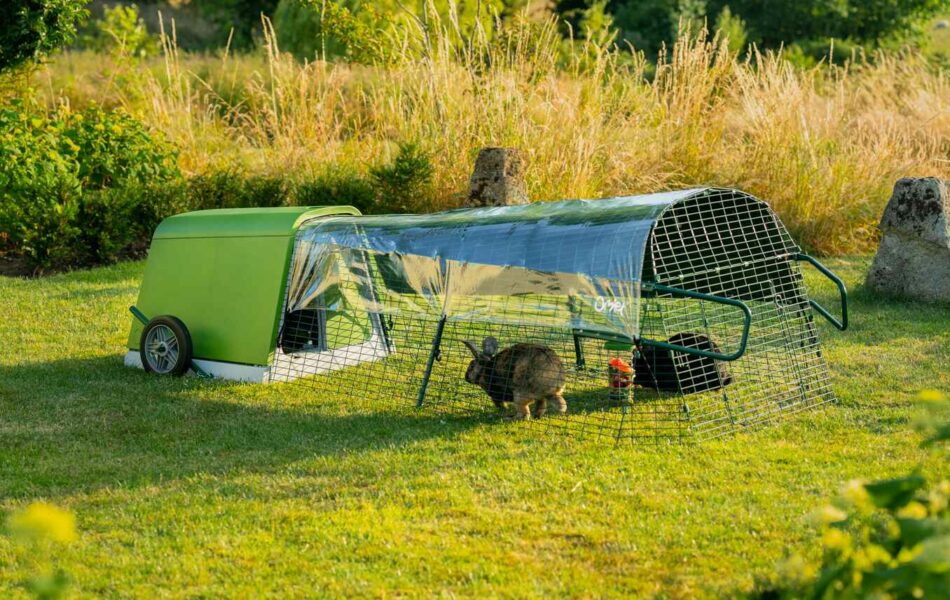
Feeding your rabbits
Rabbits need a quality pellet feed and timothy hay – which should be their primary source of nutrition. Hay should be left out free-choice and filled as needed, while pellets should be fed as directed by the packaging – roughly an egg cup a day per rabbit is a good guide. Rabbits will eat – and poop – constantly, and need the fiber in the hay to stay regular. They can become seriously ill very quickly if they stop eating and pooping, so it’s important not to overfeed them with pellets, as this can result in them not eating the necessary amount of hay.
Rabbit-safe fruits and vegetables can be offered as treats 2-3 times a week, but always in moderation. Leafy greens served in a Caddi Rabbit Treat Holder, non-starchy vegetables, and berries are the best choices. Fresh, clean water should also be available at all times for your rabbits.
Handling your rabbits
Some rabbits take kindly to being cuddled, while others are more content to receive scratches from ground-level. Either way, at some point it’s likely that you’ll need to handle your rabbit. The safest way to hold a rabbit is to angle their head so that it’s under your upper arm, with its nose pointed behind you. Tuck the rest of your rabbit’s body against your side, and secure them in a “football” hold with your lower arm and your hand wrapped around their hips. Always be mindful of your rabbit’s powerful back legs and sharp claws when handling them.
Veterinary care
There are no required annual vaccinations for rabbits in the US, and they rarely need deworming. But it’s still a good idea to have a veterinarian to contact if your bunnies ever feel ill or become injured. Not all veterinarians are equipped to treat rabbits, so be sure to select one that will treat your bunnies well before you bring them home. There are also elective vaccines for rabbits in some states to prevent contagious diseases – consult your veterinarian to discuss whether vaccinating your rabbits would be advisable.
Omlet and your rabbits
From easy to clean rabbit hutches and spacious rabbit runs, to ingenious and unique rabbit tunnel systems, we have everything you need to make your rabbit keeping journey both enjoyable and extraordinary. Create setups that are as unique as your rabbits, and build bonds with your bunnies that will last a lifetime. With Omlet, owning rabbits has never been more fun.
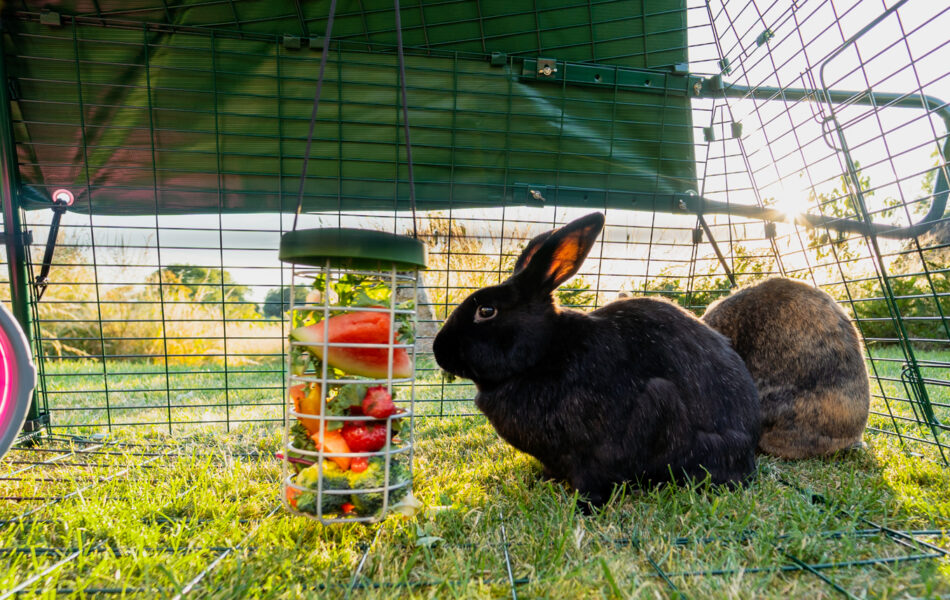

This entry was posted in Rabbits
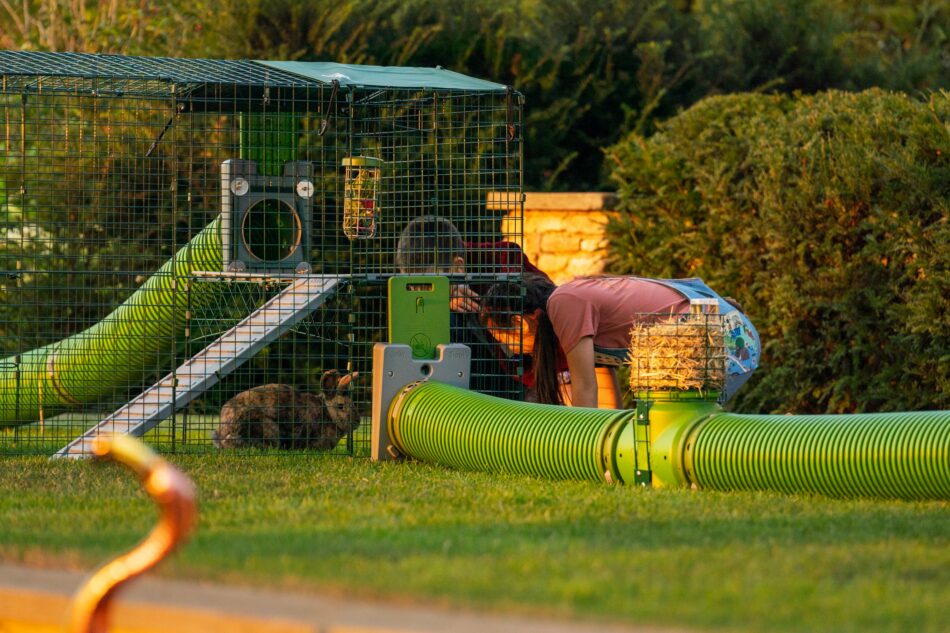
Rabbits are very curious, energetic, and social animals that thrive off of enrichment. For rabbits, enrichment comes from activities that challenge their physical abilities and appeal to their intellectual side. Fostering your rabbits’ natural behaviors and offering their minds and bodies ways to become more strong and agile are among some of the most important aspects of caring for them. We’ve outlined what this means for bunnies, and how owners can provide this type of stimuli for their pets in our rabbit enrichment 101.
Why is rabbit enrichment important?
In the wild, rabbits are constantly on high alert, looking for potential threats, future meals, and gauging weather conditions. These actions take a lot of energy – and as a result, their metabolisms are very fast. Domesticated rabbits however have caring owners that keep them protected from predators, provide their next meal, and keep them sheltered from the elements. But, these natural behaviors are still ingrained in your pet rabbits, and their resulting metabolisms and energy stores remain heightened.
A happy rabbit is an active rabbit, and to foster these behaviors and expel pent-up energy, pet rabbits need enrichment. Bunnies that don’t have engaging activities, toys, or environments can become bored – which can spell trouble quickly.
Types of rabbit enrichment
There are many ways to provide enrichment for your rabbits. From simple changes to their environment to interacting with them frequently and with toys and treats, here are ways you can enhance your rabbits’ daily activities.
Your rabbits’ enclosure
All rabbits should have a spacious rabbit hutch and run large enough for them to run and jump, and tall enough for them to stand up on their hind legs. This factor alone can cause bunnies to become bored if they’re unable to stretch their muscles the way nature intended.
Additional space can be provided with Zippi Rabbit Runs and Playpens to give your rabbits plenty of room to express their natural behaviors. Link your bunnies’ hutch and run to their playpen with Zippi Rabbit Tunnels to provide them with a system that mimics burrows in the wild. Your rabbits will love the feel of tunneling, and you’ll love the damage-free way of letting them borrow and scurry in a way that makes them feel at one with nature.
Rabbit platforms
Another way to add space and variety to their run is to use platforms with your rabbits.
Zippi Rabbit Platforms bring your bunnies up to your level to interact with you and give them a new vantage point. The space beneath the platforms gives your rabbits extra room, and a shady shelter in the summer months. Create a hideout under the platform for chillier weather, or for rabbits that like a secluded space to unwind after a day of running their tunnels.
Rabbit run accessories
Adding accessories to your rabbits’ run adds both visual appeal and excitement to their area. Play tunnels give your bunnies a place to burrow inside of their run. And, when linked with a Zippi Rabbit Shelter, your rabbits can have a modern model of bunny burrows in the wild. The solid structure mimics a warren that wild rabbits retreat to for rest and safety, and the connected tunnels enable your bunnies to feel safe when accessing their hideaway.
Rabbit toys
Toys are another way to enrich your rabbits’ surroundings. It may take some trial and error to figure out which toys your rabbits prefer – some bunnies like auditory feedback during play that toys with bells provide, while others may enjoy quiet toys that they can carry around.
Balls with or without bells (like those for cats), rabbit chew toys, snuffle mats, or puzzle toys are favorites among rabbits. DIY toys made from paper towel rolls or oatmeal containers are also entertaining and simple to make.
If your rabbits aren’t interested in playing with individual toys, try making a digging box for them. Add shredded paper or sand to a container large enough for your rabbit to hop into. All bunnies love to dig, so those who aren’t as interested in playing with toys will enjoy a good rummage through their box.
Treat holders
Elevating your rabbits’ snacktime gives them a fresh perspective along with a nutritional boost. Serving fresh greens and bunny-friendly fruits and veggies in a Caddi Rabbit Treat Holder is stimulating for both their minds and bodies. Adjust the height of the Caddi to accommodate the size of your rabbits, or to encourage them to stretch their legs to reach their treats. By offering special treats this way, you’ll encourage them to use their natural instincts – just as wild rabbits would to reach berries or other rare finds.
Affection
Rabbits also thrive on affection from their humans as a form of enrichment. Getting to know your bunnies’ love language will help you both bond through quality time and displays of affection. Some rabbits are cuddlers, while others prefer being petted or scratched while they take a luxurious stretch. Find what makes your rabbits most relaxed and meet them there. In return, you’ll notice your bunnies displaying behaviors and sounds to show their affection for you.
Omlet and your rabbits
Our ingenious designs are crafted to bring you and your bunnies closer together. Not only are the Eglu Go Rabbit Hutch and Zippi Rabbit Runs and Playpens the ideal home for your rabbits, but their low-maintenance design makes it easier than ever to enjoy taking care of your pets. And, when you add Zippi Rabbit Platforms to elevate your bunnies’ space, you’ll bring them to your level. Experience the enrichment that rabbits can offer their owners when you enrich their lives with Omlet.
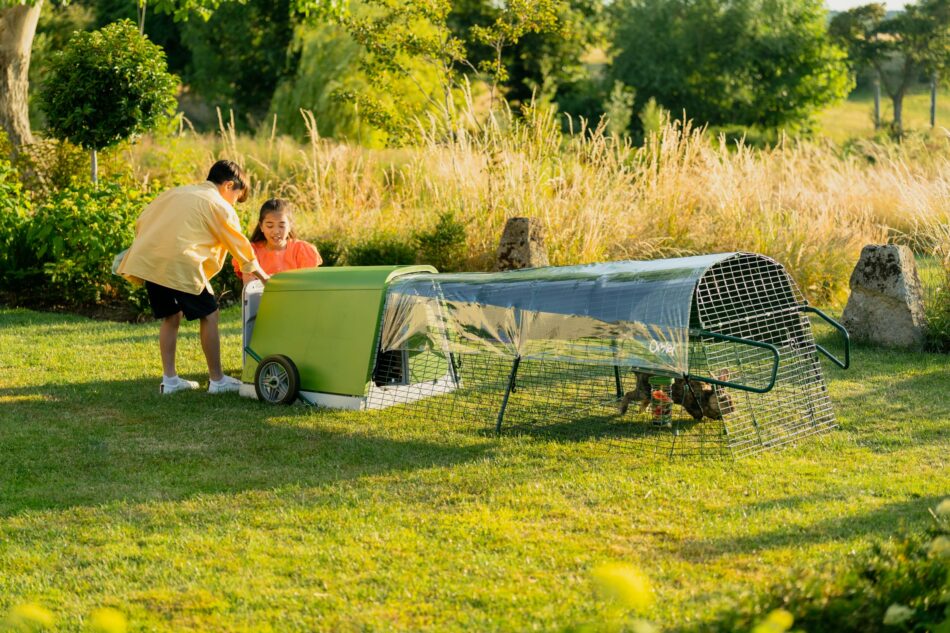

This entry was posted in Rabbits
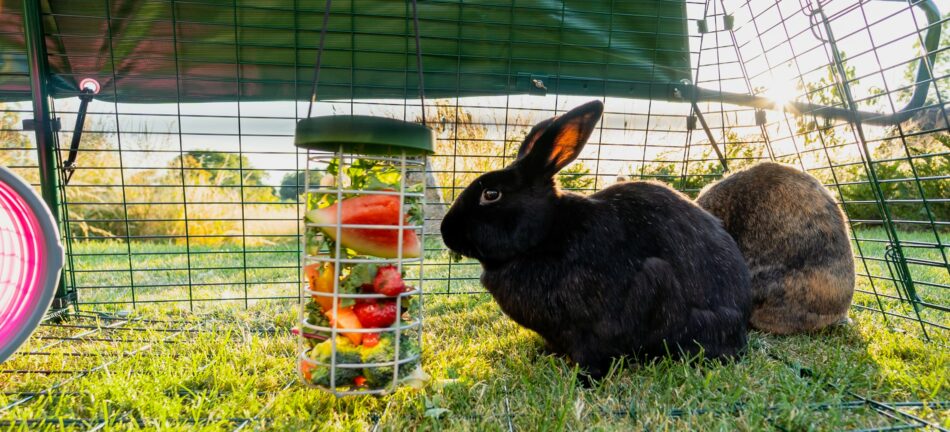
Did you know that rabbits molt twice a year? If you notice your bunny losing a lot of fur during the spring and fall, it’s likely due to this seasonal shedding cycle. But caring for your rabbits through a molt doesn’t have to be difficult — we’ll share our top tips for keeping your bunny comfortable when the fur flies.
Why do rabbits molt?
When you find fur all over your rabbits’ run, or notice them looking shaggy or unkept all of a sudden, you’re likely witnessing one of their molting cycles. Rabbits will molt twice a year — once in the spring, and once in the fall. This natural process is triggered by the amount of sunlight and the temperature of where your rabbit is kept. Your rabbit will molt:
- In the spring to shed their thick winter coat in preparation for warmer weather
- In the fall to grow a thicker, heavier coat for winter
- As babies to grow their adult coat
- As a result of stress or illness
The entire molting process takes between 2-6 weeks. Rabbits that complete their molt in 2 weeks will lose hair rapidly, leaving large amounts of fur behind. Those that take the full 6 weeks will shed their fur more slowly, so you won’t be as likely to notice the change.
You may also notice your rabbits being slightly more irritable during the molting process. They may also scratch, bite, lick, or rub at their coat in an effort to remove loose hair. Your rabbits may not want to be held during their molting cycle, as their skin will be sensitive while growing a new coat.
Care tips for your rabbits’ molt
There are a few things you can do to help your rabbits through their molting cycles. By helping them shed as efficiently as possible, you’ll be able to get back to your favorite bunny-bonding activities.
Housing and exercise
As part of the essentials needed to care for rabbits, your bunnies’ home should be clean and accommodating. It helps to have an easy-to-clean rabbit hutch — especially during molting seasons. Excess hair in your rabbits’ hutch or run can attract insects and accumulate unwanted debris, so it’s important to remove it as often as possible.
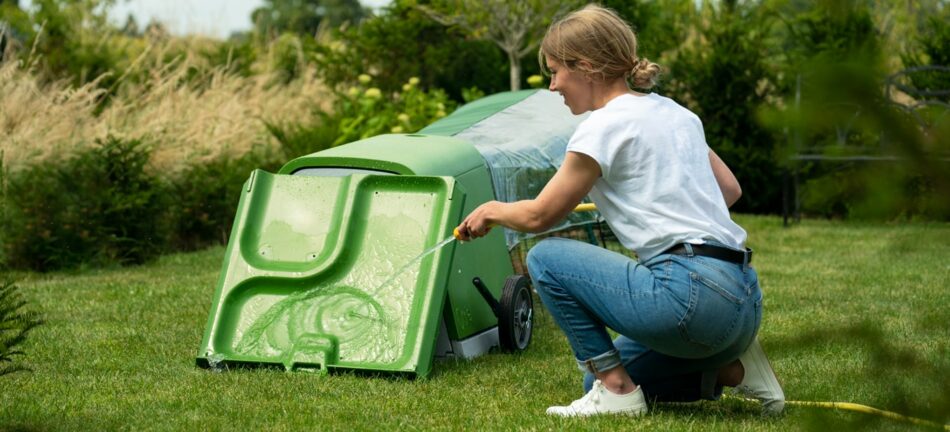
Grooming
Brushing your bunnies can help them shed their coat faster. The buildup of fur in the process of shedding can create painful mats or restrict your rabbits’ natural insulation methods. Using brushes designed to loosen undercoat fur will help prevent matting, and help keep them comfortable. Removing loose hair also helps prevent your rabbits from ingesting too much fur through self-grooming.
If your bunny doesn’t enjoy being brushed, you can also gently pull the displaced tufts of fur from their undercoat. Only attempt to pull on tufts that are obviously extended beyond the length of their top coat — otherwise, you may risk pulling hairs that are still attached.
Diet
Your rabbits should always have access to fresh, clean water, timothy hay, and quality pellets — especially during molting seasons. Growing a new hair coat takes a lot of energy, so be sure you’re giving your bunnies everything they need to fuel their bodies. Offer healthy treats like fresh leafy greens in a Caddi Rabbit Treat Holder to give their immune systems a boost during their molt.
Abnormal rabbit shedding
Healthy outdoor rabbits will molt in spring and summer, with minimal shedding in between in order to maintain a healthy coat. Indoor rabbits that aren’t exposed to as much natural light or fluctuating temperatures may gradually shed their coats throughout the year, giving the impression that they shed year-round.
If you notice your rabbits losing an excessive amount of fur outside of fall or spring, or see inflamed patches of skin during a molt, you’ll need to contact your veterinarian. Rabbits can lose or pull their fur for other reasons, like:
- Illness or skin infections
- Stress
- Pregnant females preparing a nest to have their litter
- Fighting
- Unsanitary living conditions
Provide your rabbits with consistency throughout the year to keep their stress levels low. Avoid keeping intact males together to prevent aggressive behaviors, and keep intact males and females separated to prevent unwanted litters. Monitor new rabbits closely to see if cagemates become stressed, and try to avoid frequent changes to their diet. And, always keep your rabbits in a secure, comfortable home like the Eglu Go rabbit hutch to help them feel safe in their surroundings.
Omlet and your rabbits’ molt
If you’re thinking of upgrading your rabbits’ run this fall to help them through their seasonal molt, it’s never been a better time to transition them to the ingenuously designed Eglu Go rabbit hutch. Warm in the winter and cool in the summer, pair the Eglu Go rabbit hutch with other rabbit essentials for full fur-shedding support all year round.
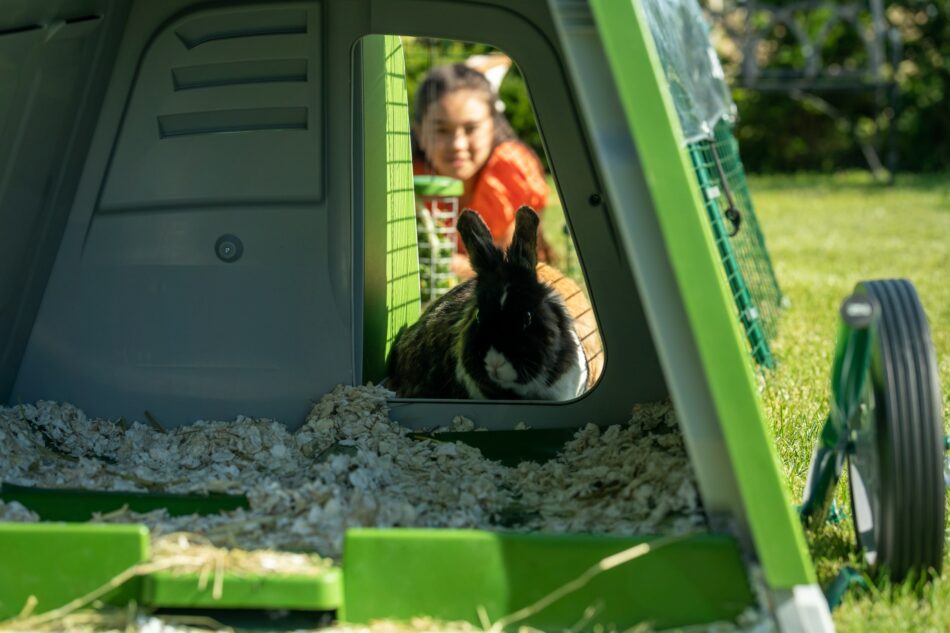

This entry was posted in Rabbits
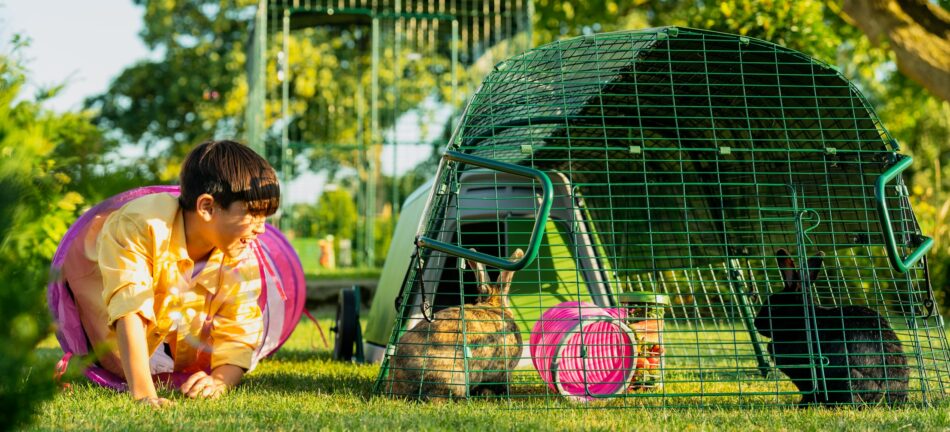
Creating your rabbits’ perfect summer setup goes beyond just making sure they have cool water and frozen treats. Rabbits can actually enjoy being outdoors during the hottest months of the year when they have the right hutch and accessories. Find out how Omlet helps your rabbits not only weather the summer heat, but thrive in it.
Rabbits and summer
Rabbits are amazingly resilient in most weather conditions. In the wild, rabbits don’t have the luxury of spending time in climate-controlled settings. But can their domesticated cousins thrive outdoors when temperatures rise?
There are many things you can do to help your rabbits keep cool in the summer. Many owners try to mitigate the risk of heatstroke in their bunnies by providing frozen water bottles and other treats, but the reality is that these round-the-clock tasks aren’t always practical or sustainable.
What rabbits really need is the right setup to thrive during the summer months. By having the right rabbit hutch, run, and accessories, you can greatly reduce the amount of time spent freezing bottles, brushing your bunnies, or worrying about flystrike in your rabbits.
Eglu Go rabbit hutch
A great rabbit hutch is one that is well-ventilated, easy to clean, and can be moved if necessary. Conventional wooden rabbit hutches don’t fulfill these requirements, bringing stress to both rabbits and their owners.
The Eglu Go rabbit hutch is the solution for every rabbit and owner. The twin-insulated walls keep the internal temperature of the hutch lower on even the warmest days, and the ample ventilation allows air to circulate freely without compromising heat barriers. And, with optional rabbit hutch wheels and handles, you can easily move your bunnies to shadier spaces throughout the day.
Best of all, the easy-to-clean plastic of the Eglu Go ensures that keeping your rabbits’ home fresh is never a dreaded chore. In just a few minutes a day, your bunnies will have a comfortable, clean abode that won’t attract flies or other pests — unlike traditional wooden hutches.
Zippi rabbit run
Rabbits thrive in space – so giving them as much as possible is vital for their health and happiness. That’s why Omlet created Zippi Rabbit Runs and Playpens.
Our pens make it easy for you to spend time with your rabbits inside of their run. With plenty of space to add dig boxes, play tunnels, or other rabbit run accessories, you and your rabbits will never feel the boredom that the dog days of summer bring. And, with the addition of rabbit run covers, you can instantly create shady spaces.
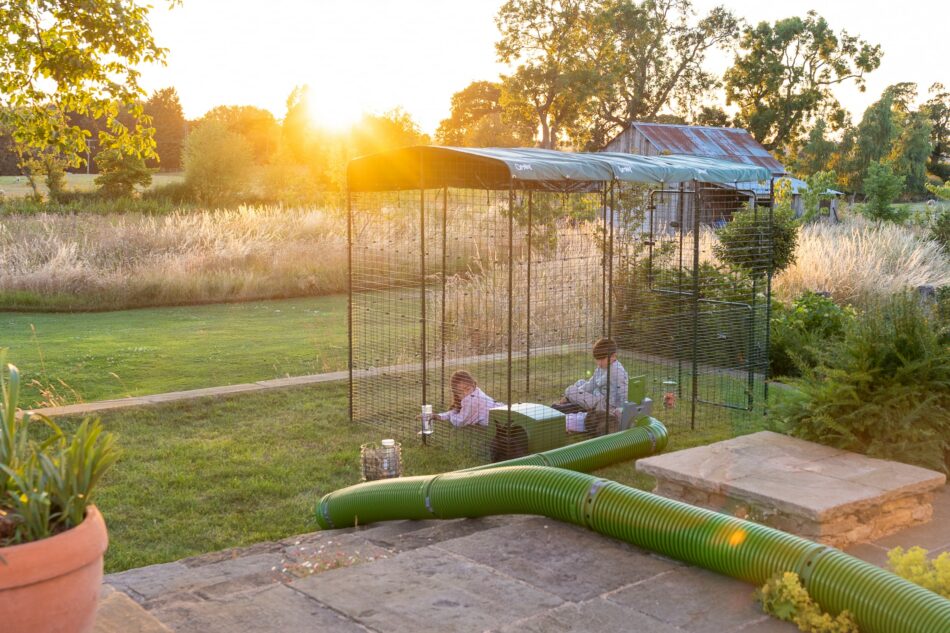
Zippi Platforms
Building a pen to enjoy with your bunnies will build your bond as well. With our Zippi Rabbit Platforms, you can add both functionality and shade to your rabbits’ run. By giving them an elevated space, you’ll be able to interact with them on a whole new level, and your bunnies will be able to enjoy shade beneath the platforms.
Use your rabbits’ Zippi Platforms for training, treating, or to best utilize their run space. No matter how you use Platforms with your rabbits, they’ll benefit from the added element and exercise opportunities.
Zippi Tunnel System
In the wild, rabbits use burrows for many things – including keeping cool. To help foster this behavior in domestic rabbits, we’ve developed the Zippi Rabbit Tunnel System. This fully customizable tunnel system can connect any rabbit hutch or run to other playpens or spaces. Each tunnel has cooling vents to allow airflow while your rabbits scurry along their routes – keeping them shaded and cool.
The more tunnels you link together, the more space your rabbits have to expel energy or relax in the shade that the Zippi tunnels have to offer. Make your bunnies’ burrows as extensive or straightforward as you’d like, and watch them take to your backyard like they would a warren in the wild.
Zippi Rabbit Shelter
For added solace from the sun, adding Zippi Rabbit Shelters to your rabbits’ run provides opportunities to escape the rays. These multipurpose hideouts are perfect for summer and winter, or to help easily stressed bunnies relax away from outside stimuli. And, with two entrances, multiple rabbits can easily share their space.
Omlet and your rabbits
Rabbits can enjoy every season outside when they’re provided with everything they need to keep them comfortable and safe. At Omlet, we’ve designed our Zippi Rabbit Runs and Playpens, Zippi Rabbit Platforms, and Zippi Rabbit Shelters to not only provide enrichment, but to create a more natural environment for your bunnies to thrive in. Bring it all together with our Zippi Tunnel System, and your rabbits can enjoy their Eglu Go rabbit hutch outdoors all year round.
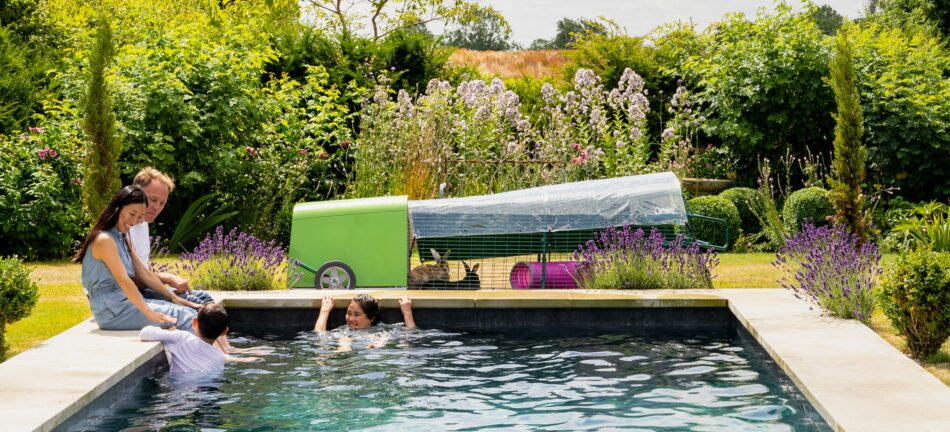

This entry was posted in Rabbits
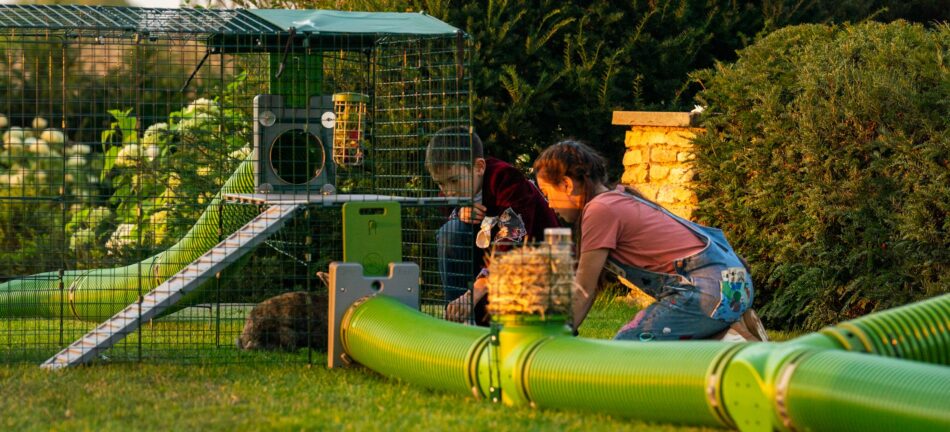
Thankfully, rabbits and flystrike aren’t a common pairing when bunnies are well cared for. Healthy rabbits that can groom themselves and have a clean environment are not easily affected by flystrike. But as prey animals, rabbits are very good at masking their discomfort – so it’s important to know what flystrike is, how to prevent it, and how to treat it.
What is flystrike?
Flystrike, also known as myiasis, is a condition where animals that live outdoors become infested with fly larvae (maggots). In rabbits, flystrike begins when Lucilia sericata (green bottle fly) lays eggs on their skin. When the maggots hatch, they take up residence on your rabbit – eating through the skin and eventually invading the deeper tissue beneath. As awful as this condition is, it’s not common in healthy bunnies. The majority of rabbits that suffer from flystrike are:
- Those that cannot groom themselves due to obesity or other illness
- Living in unsanitary housing conditions
- Soiled from urine or feces, or wounded
If your rabbit’s coat becomes overly dirty (caked on droppings, urine-soaked, or constantly damp from the weather) or their living conditions become so soiled that droves of flies are drawn to them, they are at risk of flystrike. Flies are part of living outdoors and small numbers of these flying pests are not usually cause for alarm. But, when flies are attracted to the dirty, smelly coat of a rabbit in less-than-ideal conditions, trouble sets in.
Flystrike is most common during the summer months when flies are the most active. Warmer temperatures are hospitable for maggots, and flies are in abundance this time of year. And, with more rabbits laying in the cool grass or shade during the heat of the day, flies can easily seek them out. Bringing your rabbit indoors during the hottest part of the day may help abate the nuisance from flies.
Do indoor rabbits get flystrike?
Indoor rabbits can get flystrike, but it is much less common than if they lived outdoors. The same conditions apply for indoor rabbits to become affected by flystrike, and it’s less likely that those living indoors would have unsanitary coats or living conditions. And, houses tend to have fewer flies inside than the outside world.
Keeping your home clean with indoor rabbits is essential to avoiding flies. If you’re bringing your outdoor rabbits inside for brief periods during the day, make sure you’re not bringing flies in with them. Clean their indoor spaces daily to deter flies from accumulating.
6 signs & symptoms of flystrike in rabbits
Flystrike can occur rapidly, as maggots can hatch within mere hours of eggs being laid. Maggots seek out a food source as soon as they hatch, meaning your rabbit is in imminent danger of becoming a host for them. Bunnies may exhibit any of the following signs if they’re suffering from flystrike, so it’s important to perform regular rabbit health checks to evaluate their health.
1. Presence of maggots
The first symptom of flystrike is the presence of maggots. Fly larvae start out small and are worm-like in appearance. Flies lay their eggs on the part of the animal they are most drawn to. In the case of rabbits, this will usually be around the tail where urine and feces are most likely to be present.
2. Lethargy
Your rabbit may appear listless or dull when they’re in pain. Flystrike causes extreme discomfort, so your bunny is likely to be less active and will be hesitant to move in most cases. Lethargic rabbits may also spend more time inside of their hutch.
3. Loss of appetite
Most animals (rabbits included) will be off of their feed when they aren’t feeling well. If your rabbit isn’t eating or drinking, there’s a good chance there’s something going on with them. Flystrike can cause a weakened or dehydrated rabbit to go downhill rapidly.
4. Increased digging
Agitated rabbits in pain may dig more in an effort to relieve their discomfort. Look for signs of your rabbits digging in corners in particular. Claw marks on the inside of hutches, outside in the run, or in bedding can be telling of a rabbit in pain.
5. Odor from enclosure
As you can imagine, flystrike causes a foul odor. The smell of the decaying flesh that the maggots leave in their wake is not a subtle sign. This sign usually occurs as flystrike progresses to a dire level.
6. Shock
The final stage of flystrike is shock. Shock sets in when a rabbit’s body is overwhelmed by pain, infection, or external stressors. Flystrike brings all of these conditions, making it very dangerous for rabbits. Symptoms of shock include:
- Rapid breathing
- Pale mucous membranes (eyes, gums)
- Seizures
- Unconsciousness or collapse
- Death
If you notice any maggots on your rabbit, or any of the above signs or symptoms, be sure to contact your bunny’s veterinarian right away. Prompt treatment is necessary to combat flystrike.
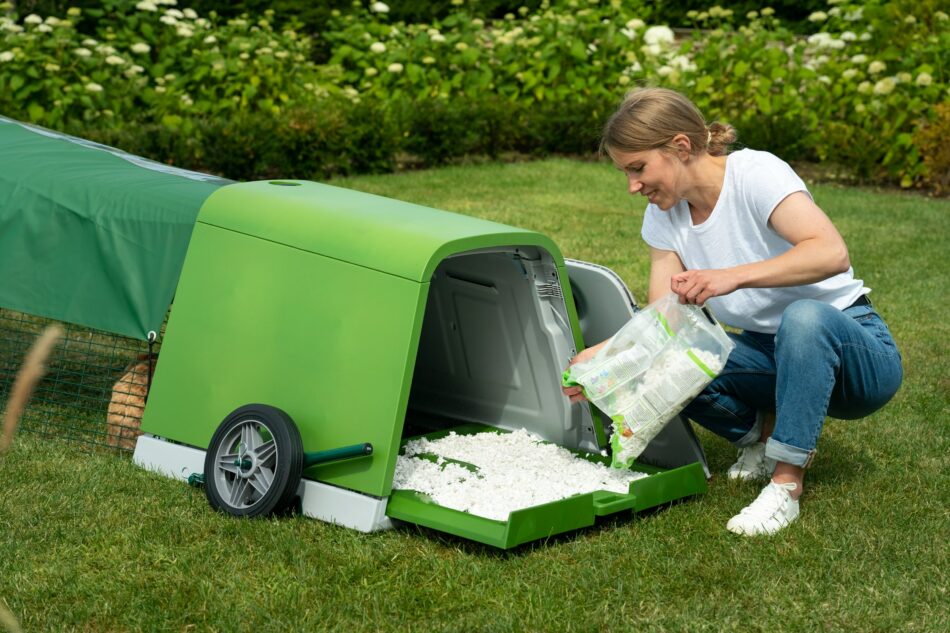
Which rabbit breeds are more prone to flystrike?
Any breed of rabbit can fall victim to flystrike, but some may be more susceptible than others depending on environmental factors. Lionheads or Angora rabbits have longer coats than other breeds that can become soiled quickly without regular grooming. Large breeds like the Flemish Giant are more prone to obesity due to their size, and overweight rabbits can’t groom themselves as thoroughly as bunnies that are the ideal weight.
How to prevent rabbit flystrike
Keeping your rabbit’s home clean is one of the most important and effective ways to prevent flystrike. Cleaning your rabbit’s hutch and refreshing their bedding daily in the summer is essential to combating flies. The Eglu Go Plastic Rabbit Hutch by Omlet can be thoroughly cleaned in just a few minutes each day, and has ample ventilation to prevent odors from building up. The expandable attached run gives rabbits plenty of room to run and lounge, spreading out their droppings to further deter flies from gathering.
For even more space to escape flies, our Zippi Rabbit Tunnel System can be connected to your hutch and rabbit playpen to create a larger area. You can also add platforms to playpens to encourage more exercise and prevent your rabbits from becoming overweight. Combined with a balanced bunny diet, Zippi Rabbit Platforms will help your furry family members stay in tip-top shape.
How to treat rabbit flystrike
Flystrike is a medical emergency and you should contact your rabbit’s veterinarian right away to prevent irreversible damage. Do not attempt to treat or remove burrowed maggots yourself, as pieces can break off inside of your rabbit and cause infection. Rabbits with flystrike will need prescription antibiotics and pain medication to make a full recovery.
Omlet and caring for your rabbit
Omlet’s rabbit products help keep your rabbits healthy and happy. Our easy-to-clean designs were created to help owners spend less time cleaning and more time playing with their pets. The Eglu Go Rabbit Hutch, Zippi Rabbit Platforms, and Zippi Tunnel System are all easy to keep clean, and encourage more movement from your bunnies to promote overall health. Combat flystrike and other dangerous conditions when you house your rabbit in expertly crafted setups by Omlet.
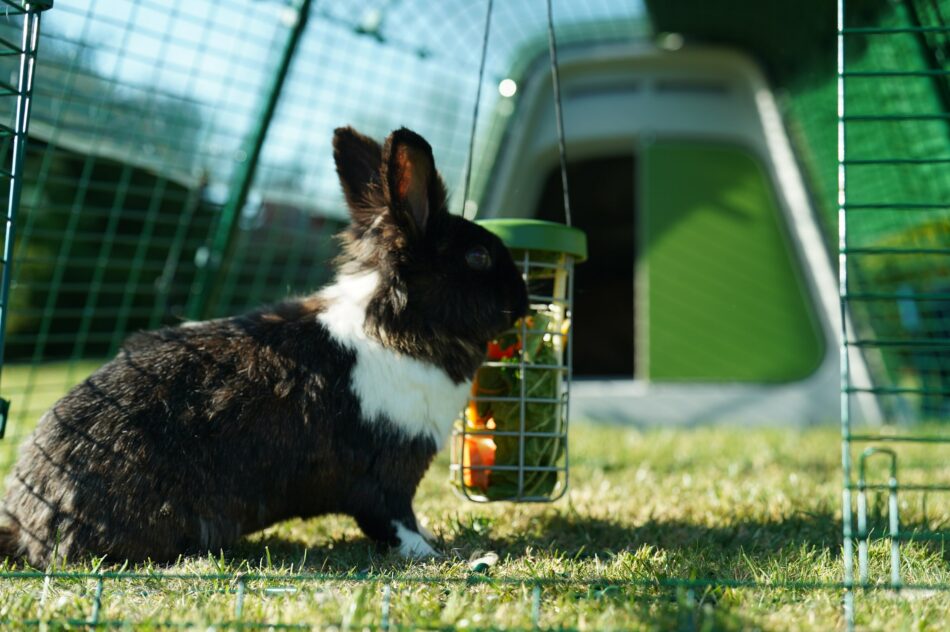

This entry was posted in Rabbits
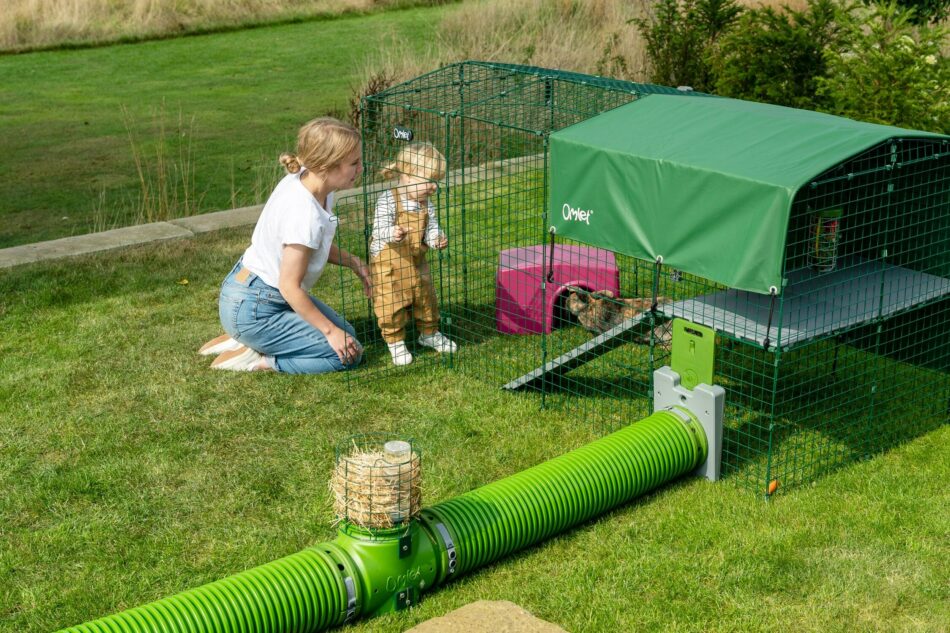
With so many different species of animals to choose from, many parents find themselves asking: Are rabbits good pets for children? The short answer is yes, as long as there is mutual understanding between rabbits and their owners. Bunnies can be wonderful pets, full of personality and adorable antics when they’re able to exhibit their natural behaviors. With complete rabbit setups from Omlet, your children will begin bonding with their bunny right away, and for years to come.
Why rabbits can make great pets for children
Rabbits are intelligent, sociable, and relatively low-maintenance. These attributes are some of the reasons why bunnies make great first pets for children. Rabbits can be housed indoors or outdoors, but are happiest when they are provided with as much space as possible. In the wild, rabbits live in extensive underground burrows and tunnels – and their domesticated counterparts share the same desire to navigate these structures.
Omlet’s Zippi Rabbit Tunnel System simulates the tunnels and burrows that rabbits would construct in the wild. Combined with our Zippi Rabbit Runs and Platforms, your bunnies will be scurrying, bounding, and exploring just as they would naturally. And, you can let your children pick out rabbit run accessories to further customize their pets’ space.
Our Eglu Go Rabbit Hutches are the perfect size bunny abodes for both pets and children. The easy-to-clean structure will enable your kids to clean their pet’s home with ease, and will keep your yard smelling fresh. And, with optional wheels and handles, our Eglu Go hutches and attached runs can be maneuvered around the yard with ease.
Creating a rabbit’s ideal space is just one of the many ways to bond with your bunny. Our rabbit products are designed to bring you and your bunny closer than ever. With the right setup and some quality time, your family will have forged a relationship with your rabbit that will last a lifetime.
Rabbits and children: 3 things to consider
While it’s true that rabbits can make excellent first pets, it’s important to set realistic expectations for both your bunny and your children. Make sure your kids are prepared for the responsibilities associated with owning a rabbit, and are familiar with bunny behaviors and body language.
1. Bunnies should have buddies
Rabbits do best in groups of two or more. In the wild, colonies of rabbits can consist of anywhere from two to dozens of bunnies. A lonely rabbit can act out or display attention-seeking behaviors. Adopting a pair of bonded rabbits is the best way to start off on the right foot, but you can also adopt young rabbits to raise together. Make sure that any males are neutered – even if you only keep males. Intact male rabbits can become territorial when kept together, and unaltered males kept with females will result in unwanted litters. Intact females can usually be kept together with no issues.
2. Rabbits are a long-term commitment
The life expectancy of rabbits is 8-12 years, so they can be a long-term commitment. Make sure plans are in place for when your children and rabbits are older. Will they take their pets with them when they move out? Do you have younger children to care for the rabbits once their siblings are grown? Or, are you willing to continue caring for the rabbits yourself?
The Eglu Go Plastic Rabbit Hutch is the only home you’ll need to buy for your rabbits. Designed to last a lifetime, our rugged construction of heavy-duty plastic and rot-free materials will stand the test of time. It should be noted that only rabbits over the age of 6 weeks old should be housed outdoors. Younger rabbits have more trouble regulating their body temperature, and will fare better when gradually introduced to outdoor temperatures. This also applies to older rabbits that were raised indoors. Introduce rabbits to life outdoors in small increments over the course of a couple of weeks to make the transition as smooth as possible.
3. Bunnies need boundaries
Any rabbit can be housed outdoors, and most fare better when they’re allowed to live outside. Not only does it mimic their natural habitat, but being outside gives them reprieve from the hustle and bustle of a household. Understanding your bunny’s body language will clue you in on how they’re doing in their surroundings. And, as with most pets, giving your rabbits as much space as possible will help ensure they’re healthy and happy as possible.
Omlet’s Zippi Rabbit Playpens help create boundaries for your bunnies in any setting. Perfect for designated spaces outdoors, or as indoor playpens for a change of scenery, our Zippi Playpens are easy to move and are predator-resistant for peace of mind.
The attached run of the Eglu Go Rabbit Hutch can also be extended to up to 12 feet long, giving your rabbits plenty of room to roam.
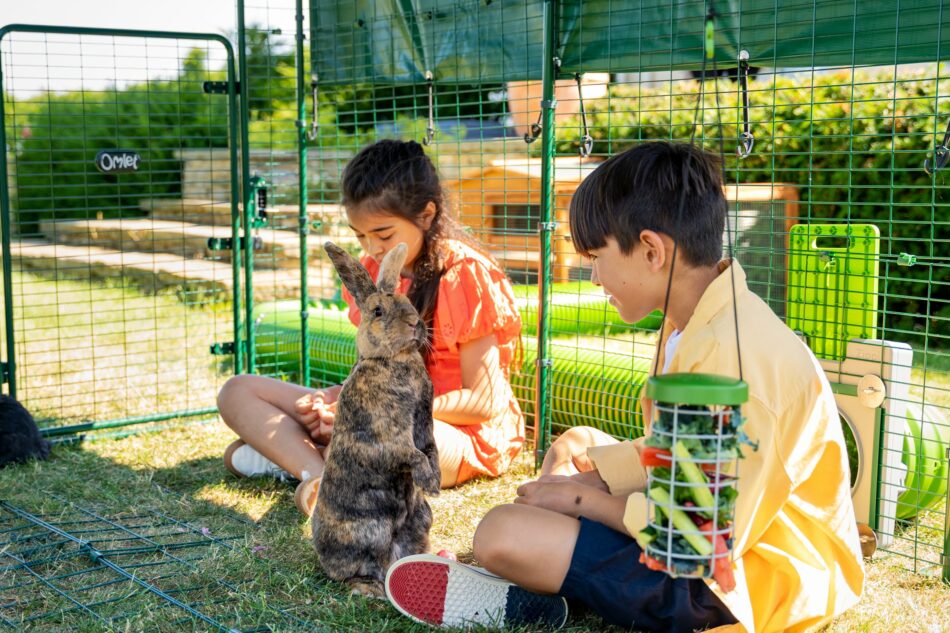
Best rabbit breeds for children
Once you’ve decided that rabbits will be a good fit for your family, it’s time to decide on the breeds of bunnies you’ll want to keep. Choosing the right rabbits largely comes down to personal preference and your space or climate.
For example, breeds like the Lionhead rabbit are excellent for children due to their docile nature, but may not be suited to life outdoors in hot or humid weather. Californians are considered to be a hardy breed in all climates, as well as being known for their sweet temperaments. Other breeds that are good for children include:
Flemish Giants also make excellent pets, but due to their size require plenty of space.
Omlet and your pet rabbit
Omlet aims for owners to raise their rabbit-readiness status quickly and easily. Our line of bunny products like the Eglu Go Rabbit Hutch, Zippi Rabbit Playpens and Platforms, and Zippi Rabbit Tunnel System are all designed to make rabbit ownership truly remarkable. At the end of the day, parents have to ensure that their children are caring for their pets properly, but with Omlet, helping your children with chores becomes a joy. With Omlet, you’ll bring your entire family closer together – both with each other and with your pets.
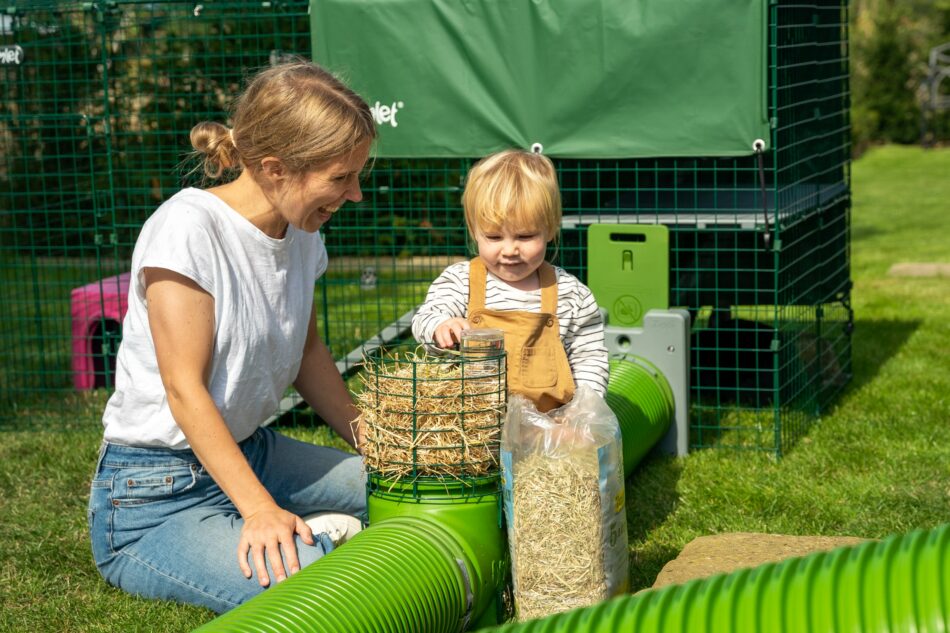

This entry was posted in Rabbits
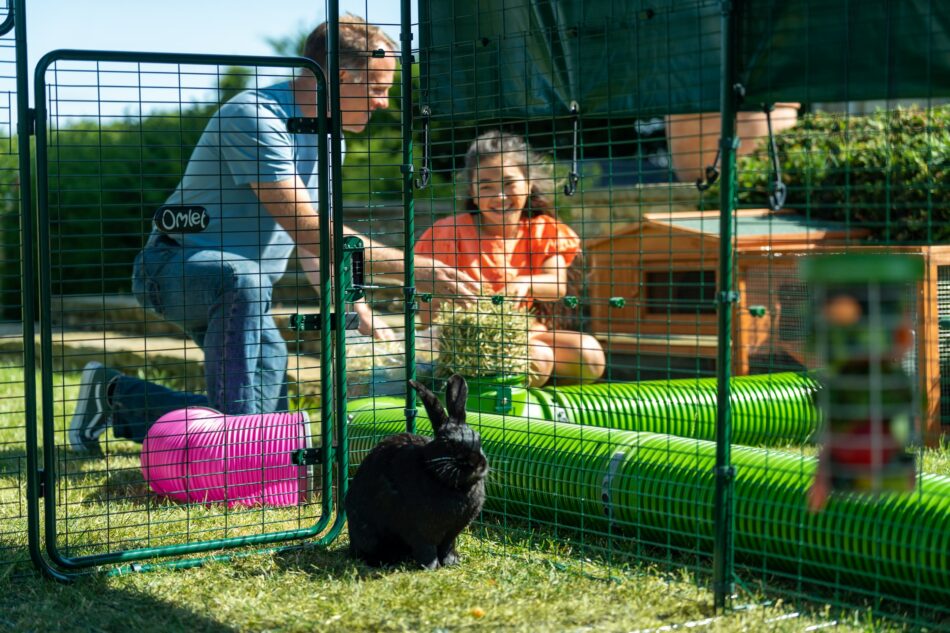
Keeping rabbits for beginners doesn’t have to be intimidating. In fact, these gentle animals are perfect for first-time pet owners due to their relatively easy care. With the right rabbit setup and research, you’ll be bonded with your bunny in no time.
Which rabbit breed?
There are many breeds of rabbits available as pets. They vary widely in appearance, size, and temperament. Some require more maintenance than others, mostly because of their long coats and heat or cold tolerance.
For example, Lion Heads have long coats in need of regular brushing to prevent mats from forming. They also aren’t as heat tolerant as other breeds due to their excess hair. On the other hand, breeds like the Californian are very heat tolerant and have short haircoats that don’t require grooming.
Rabbits may have erect or “lop” (long, floppy) ears. The anatomy of their ears doesn’t affect them much, except in the case of breeds like English Lops, as they are prized for their very long ears. These large, long-eared rabbits may be more prone to stepping on their ears in enclosures that are too small for them.
The breeds considered to be best for beginner bunny keepers include:
The type and age of the rabbit you choose is largely a matter of personal preference. Most breeds have the same basic care needs, but be sure to research the breeds you’re considering thoroughly before making a final decision.
You’ll also want to decide if you’d like to start with a young bunny or an adult. Rabbits of all ages need to be handled regularly in order to bond with their new owners, but young rabbits may forge this bond faster than adult bunnies that have had previous owners. Like other pets, bunnies have their own individual personalities that may not be apparent right away. Give your rabbit time to adjust to their new home, and you’ll soon see their personality shine through.
How many rabbits should I get?
Rabbits are social animals that thrive off of bonds with each other. It’s always advised to keep at least two rabbits together to avoid a lonely bunny. In the wild, rabbits live in large groups called “colonies” and all live together in a network of tunnels and burrows called a “warren.” Colonies can consist of just two or three rabbits, or in the dozens.
Domesticated rabbits share many of the same characteristics as their wild cousins, so the need for companionship runs deep. Decide how many rabbits you’d like to keep together, which will determine how much space they’ll need to be comfortable. To avoid accidental litters, only keep neutered males with females, or stick to females only. If you plan to keep more than one male, they should all be neutered to prevent territorial displays.
Your new rabbits’ home
Omlet has created the perfect home for pet rabbits. The Eglu Go Plastic Rabbit Hutch is designed to meet all of your bunnies’ needs, as well as yours. Our easy-to-clean design keeps your rabbits fresh and clean and makes caring for your bunnies easier than ever.
Our plastic rabbit hutches have revolutionized rabbit-keeping. Gone are the days of rotting, moldy, smelly wooden rabbit hutches. With an Eglu Rabbit Hutch, you’ll never have to worry about maintaining the ideal environment for your bunnies.
Since rabbits need as much space as possible to keep fit and active, we’ve come up with several solutions that are conducive to any outdoor area. The attached run of the Eglu Rabbit Hutch can be extended up to 12 feet long, or your rabbit can explore new areas of your yard with an Outdoor Rabbit Run. Place your rabbit’s hutch inside of one of these rabbit runs, or connect the attached hutch run to the secondary run with our one-of-a-kind Zippi Rabbit Tunnel System. Designed to mimic tunnels and burrows in the wild, your rabbits will have their own backyard warren to keep them safe and happy all year round.
All of our rabbit products are predator-resistant, and feature optional anti-dig floor mesh to help prevent your bunnies from tunneling out. Optional handles and wheels can also be added to your rabbits’ hutch to move them around to fresh patches of grass, or shady areas of your yard.
New rabbit checklist
All pet rabbits need the same basic care and supplies. To complete your new rabbit checklist, be sure to have:
- A quality rabbit hutch to keep them comfortable and secure
- High-quality feed, ideally pellets comprised mainly of timothy hay
- Free-choice timothy hay
- Fresh water available at all times
- Chew toys to trim their ever-growing teeth
- A good veterinarian that’s familiar with rabbits
Bunnies thrive best when they’re given enrichment opportunities. Our outdoor rabbit runs combined with Zippi rabbit tunnels will help keep your rabbits’ minds and bodies active. Add weather protection to your rabbits’ run so that they can enjoy time out of their hutch – rain or shine.
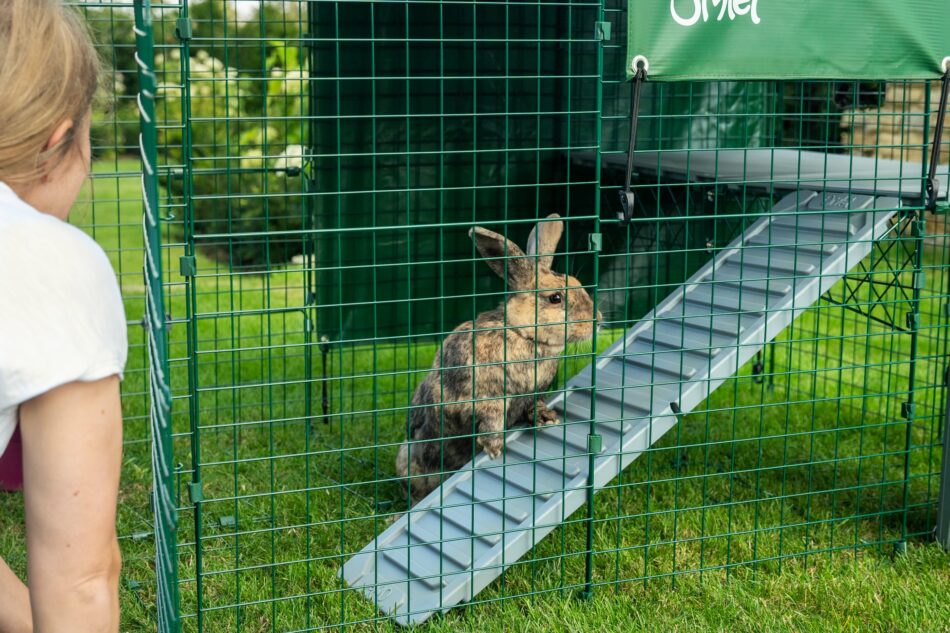
3 tips for beginning rabbit keepers
Excited to get started on your rabbit-keeping journey? Below are the top tips to help ensure success from the start.
Conduct rabbit research
Before bringing your bunny home, you’ll want to research the breeds you’re interested in keeping, along with their enclosure and dietary needs. Some breeds require more space than others, while some breeds have different protein requirements in their diet. It’s always recommended to find your rabbits through a reputable breeder. Breeders are excellent resources for first-time bunny keepers and can help you with the specifics of the breed you’ve chosen.
Establish a rabbit routine
Your routine with your rabbits will be unique to you as an owner, but a realistic schedule should look something like this:
Morning:
- Fill food bowl with pellets
- Refill hay feeder
- Refresh water bottle
Afternoon:
- Playtime
- Refill water if needed
Evening:
- Clean hutch and refresh bedding
If your rabbit has a long coat in need of grooming, you’ll need to make time to brush them a few times each week. Check your rabbits’ toenails monthly to see if they need a trim. Keep in mind that bunnies that have access to fresh earth will wear their nails down faster through play and digging than those kept in wire cages. If your bunny needs a nail trim, be sure you’re comfortable doing so on your own. Otherwise, your veterinarian can trim their nails for a modest fee.
Bond with your bunny
To have the best relationship with your rabbit, you’ll need to spend time with them each day. Once you get to know them, you’ll be able to understand your bunny’s body language. Handle your rabbits often to get them comfortable with you, and offer treats to reinforce desired behavior. Fresh fruits and vegetables are great rewards for training, as well as nutritious additions to your rabbit’s diet. Serve them in a Caddi Rabbit Treat Holder to keep your rabbit occupied in your absence.
Talk to your rabbits every time you interact with them to get them accustomed to your voice. Your bunny may be nervous the first few days in their new home, but with patience and care, you’ll earn their trust. Happy rabbits have clean, safe hutches, a well-balanced diet, and plenty of room to run around in. And, as any rabbit keeper will tell you, a happy rabbit is a joy to be around.
Omlet and your rabbit-keeping journey
Omlet’s rabbit products have been designed to keep rabbits and their owners happy — no matter where they are on their journey together. From seasoned rabbit owners, to complete beginners, our rabbit hutches, Zippi tunnel system, and outdoor rabbit runs bring joy to bunnies and their humans alike. You can rest easy knowing that your rabbits are living their best lives in their Omlet setup, and enjoy being a rabbit keeper with our easy-to-clean, zero-maintenance rabbit products.
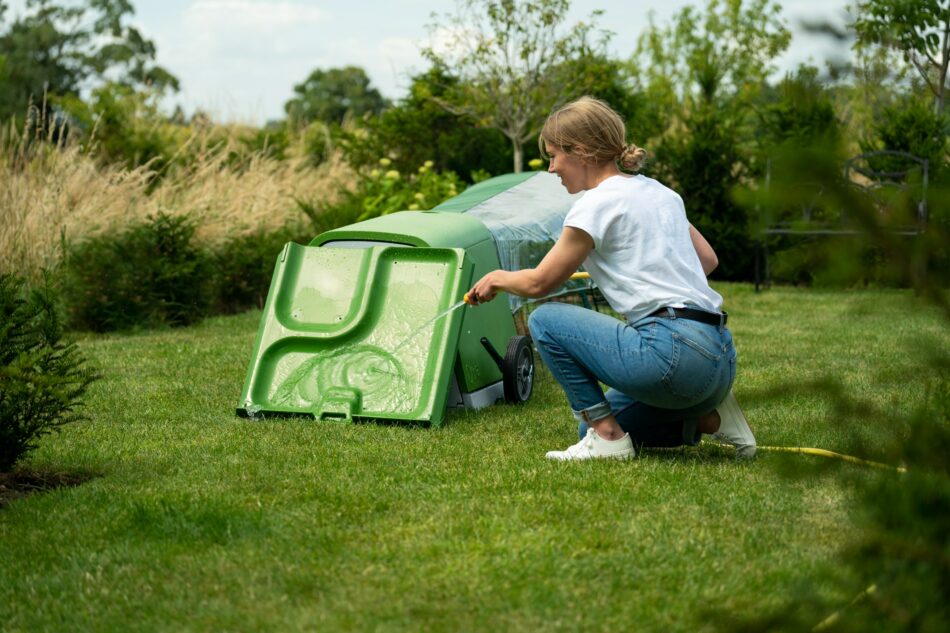

This entry was posted in Rabbits
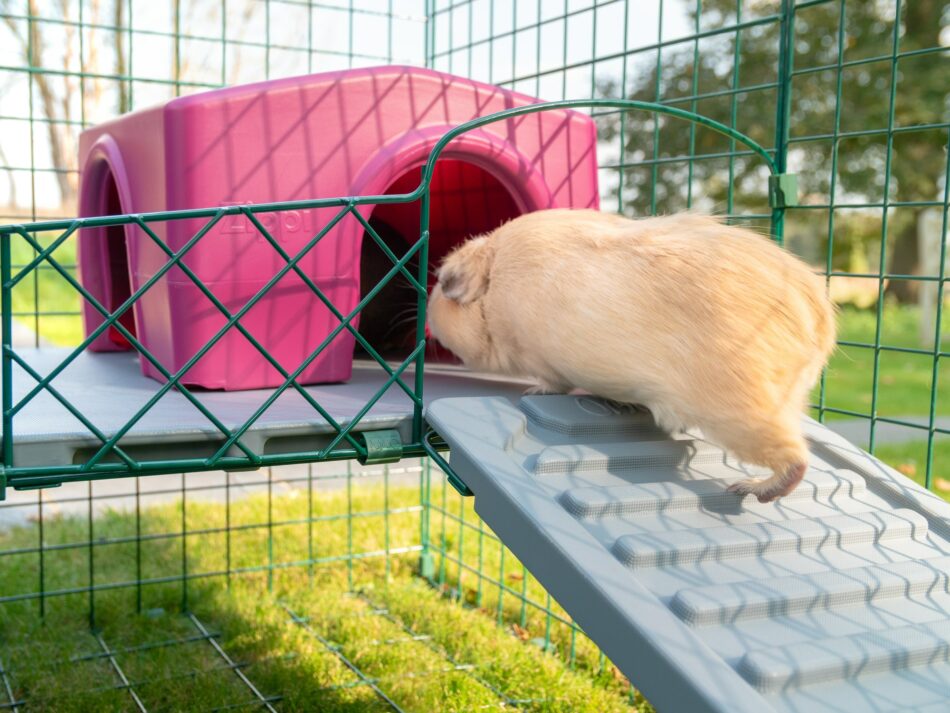
Rabbits and guinea pigs need exercise – and lots of it. Bunnies and cavies can become bored quickly without enough physical and mental stimulation, and a lack of activity can create these small pets to gain an unhealthy amount of weight. Adding levels to your rabbit or guinea pig’s enclosure through the use of platforms encourages more exercise and builds strength.
Physical and mental well-being
Exercise is important to rabbits and guinea pigs to keep them both physically and mentally fit. Keeping small animals at an appropriate weight is essential to their longevity. Accomplished through a balanced diet and plenty of space to be active, a rabbit or guinea pig kept at a healthy weight will remain active far longer than their overweight counterparts.
Omlet’s Zippi Platforms for rabbits and guinea pigs are designed to add extra space to your pet’s run. More space in their enclosure offers more opportunities for enriching activities and accessories. Teach your bunny or cavy new tricks on their platform to further stimulate their critical thinking skills.
Prevent the risk of injury and obesity
Rabbits and guinea pigs that spend the majority of their time in their enclosures aren’t able to exercise as much as their cousins in the wild. Wild cavies and hares run long distances, burrow, scurry, and don’t have constant access to food. Our pets that descended from these wild animals have slower metabolisms as a result of breeding and circumstance and rely on care from their owners to remain fit and healthy.
The use of ramps to access Zippi Platforms strengthens muscles and offers mental stimulation. Our platforms can be easily repositioned for rabbits especially to add more height. By exercising at an incline, your rabbit or guinea pig will utilize their muscles in ways that a one-dimensional enclosure can’t offer.
Overweight pets are prone to joint pain, health issues such as diabetes or other metabolic diseases, and decreased lifespan. Regular veterinary checkups can help you determine if your rabbit or guinea pig is receiving adequate nutrition and exercise. You can also do a quick check at home to see if your pet is overweight by gently pressing along the sides of your rabbit or guinea pig’s abdomen. Can you feel their ribs? You should be able to feel the distinct ridges of your pet’s ribcage without having to press too firmly. If you can’t feel their ribs, they’re likely overweight.
Along with exercise, diet is critical in keeping your rabbit or guinea pig healthy. Offer high-quality pellets that are timothy hay-based, and offer free-choice loose timothy hay or orchard grass. Treats should be given sparingly, and should consist of fresh greens rather than store-bought treats. Other guinea pig and rabbit-safe treats can be offered, but are best utilized during training sessions or other special occasions.
Platforms: a multitude of possibilities
Rabbits and guinea pigs grow bored easily in their surroundings. By adding platforms to their run, the topography of their environment can be changed regularly. Try feeding them on their platform one week, and below the platform another week. You can also place their favorite bed or toy at the top of the platform to encourage climbing up and down the ramp.
Small pets are also prey animals, which means they appreciate a higher vantage point. Your guinea pig or rabbit will appreciate the opportunity to scamper and scurry to the top of their platform to get a new look at their world.
Create the ultimate playspace for your rabbit or guinea pig. Omlet’s Zippi Platforms can be easily adjusted to a height that accommodates your pet’s personality and skill level. They can also be repositioned easily around the run to change up your bunny or cavy’s enclosure regularly. Our non-slip design builds confidence in your pets, allowing them to navigate the ramps and platforms with ease.
An easy way to have fun together
An elevated space in your rabbit or guinea pig’s run gives you a chance to interact with them on a higher level – literally! Sit with them at eye level, train on a flat and accessible surface, and customize their run with the use of Zippi Platforms. A designated training space will help you train your rabbit or guinea pig to perform tricks, giving you a clear, easily accessible area to work with your pet.
The first training opportunity you’ll find with your rabbit or guinea pig is getting them comfortable with their ramp and platform. Offer your rabbit or guinea pig’s favorite treats in a Caddi Guinea Pig or Rabbit Treat Holder placed at the top of the ramp. This will be the easiest way to help your pet get the hang of going up to the platform – especially if they are food-motivated. Once they are comfortable using their ramp and platform, you can begin teaching your rabbit or guinea pig additional skills.
Omlet and your small pets
Omlet is dedicated to designing products that thrill both pets and their owners. From unique rabbit and guinea pig shelters, to our customizable and versatile Zippi Tunnel System, we’ve got what you need to create the ultimate experience for your small pets. Foster your rabbit or guinea pig’s natural instincts while providing a visually stunning enclosure to enjoy in your yard or garden. With Omlet, owning and caring for your pets has never been easier.
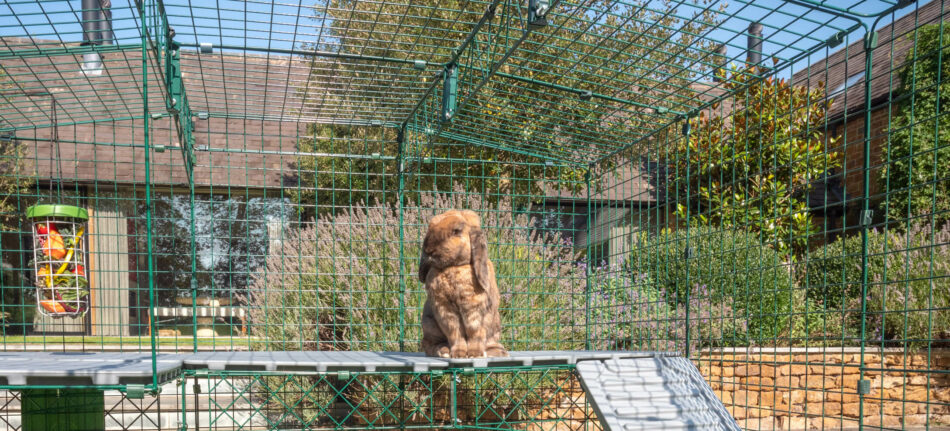
This entry was posted in Guinea Pigs

Rabbits make excellent pets for owners of all ages. Once you have all of the rabbit care essentials you need, bunnies are easy to take care of. They can be litterbox trained similarly to cats, are capable of bonding with their owners, and are a joy to watch. Like all pets, bunnies need love, attention, and proper housing to live a healthy and happy life.
Omlet has designed products that meet your rabbit’s needs, while making caring for them as easy as possible for you. Our line of rabbit products set you up for success with your bunny from the very beginning, and for the years to come. Let’s explore what life with rabbit products by Omlet looks like.
The perfect rabbit hutch
Does the perfect rabbit hutch exist? We think so! The Eglu Go Rabbit Hutch checks all the boxes for both bunnies and their keepers. Here are some reasons why:
- The dual-insulated walls of the Eglu Go Rabbit Hutch keep your bunny cool in the summer and warm in the winter
- All plastic construction and a removable bedding tray make cleaning a breeze
- An easy-access rear panel and pivoting hutch door keeps your rabbit accessible
- The attached run has anti-dig flooring and can be expanded for even more space
Plastic vs wooden rabbit hutches
Your rabbit’s hutch is where they will spend the majority of their time, so it’s important to choose the right one. There are a lot of rabbit hutch options out there, but a quality rabbit hutch should be safe, well-constructed, and built to last for years.
Plastic rabbit hutches are far superior to traditional wooden hutches. Most notably, rabbits have a natural desire to chew in order to keep their ever-growing teeth trimmed short. But, this spells trouble for wooden hutches, as they quickly become a chew toy for your bunny. Over time, chewing weakens the structural integrity of wooden hutches, which makes your rabbit vulnerable to unwanted visits from predators.
Omlet’s Eglu Go Rabbit Hutch will never succumb to rot like wooden hutches, and will never need touch-up paint or re-roofing. Plastic is not appetizing to rabbits, so you won’t have to worry about your bunny gnawing on their house. And unlike wooden hutch wire, our heavy-duty wire panels that make up the attached run are complete with mesh flooring to prevent your bunny from burrowing out of their enclosure.
Accessorize your rabbit’s home
Rabbits are extremely active animals. From wild hares to pet bunnies, rabbits need exercise and enrichment to stay physically and mentally fit. They need plenty of space to run, hop, and scurry, so you’ll need to give them as much room as possible.
Our Zippi Rabbit Tunnel System can extend your rabbit’s domain while fostering their natural burrowing behavior. Zippi Tunnels can be attached to any type of wooden hutch or wire run, and have multiple customization options. Expand and change your rabbit’s Zippi Tunnel System at any time with connection pieces, additional tunnels, and accessories.
Add vertical space with Zippi Rabbit Platforms inside their run for maximum space-enhancing fun. Using platforms with your rabbits allows for training and exercise opportunities, as well as shady areas below for rest after a long day of play. Platforms are great places to keep your rabbit’s food and water, as they are accessible and easy to clean.
What about indoor rabbits?
If you choose to house your rabbit indoors, it’s still a good idea to have a safe space for them outside to stretch their legs. Bunnies love to nibble on fresh grass and other rabbit-safe vegetation. You can even add rabbit-friendly plants to your garden to make your bunny’s outdoor space even more enjoyable.
Our Zippi Rabbit Runs and Playpens are excellent options for rabbits to spend some time outside. Floor panels keep your bunny from burrowing out, while still allowing plenty of grass through to be nibbled on. And, Zippi Runs and Playpens are easy to move around your yard to give your rabbit new areas to explore.
Make sure your home is rabbit-proof if you keep your bunny indoors. Even if your rabbit isn’t left to its own devices indoors, if an accidental hutch escape occurs you don’t want them getting themselves into trouble. Common household hazards to rabbits include:
- Low-hanging power cords
- House plants, many of which can be toxic to rabbits
- Silk or artificial plants (if they look real, your rabbit is likely to try a nibble)
- Other pets such as dogs or cats
- Doors that lead outside
Rabbits are very adaptable to life outdoors, so unless your area experiences extreme heat or extreme cold, housing your rabbit outside in an Eglu Go Hutch and Run is a great alternative to keeping them inside. For extremely hot days, you may want to have a temporary indoor enclosure to bring your bunny inside during peak temperatures. In sub-freezing temperatures, supplemental Extreme Temperature Jackets for the Eglu Go Hutch can be used for an additional layer of insulation.
A good quality diet
Now that your rabbit has the perfect home, it’s time to select their feed. There are so many commercially available rabbit feeds that it can be overwhelming to choose which is best for your bunny. Knowing what breed of rabbit you have and how old they are will help you determine which food is best for them. For example, younger rabbits need more protein in their diet than adults.
All rabbits need quality pellets that are made primarily from timothy hay. Rabbit feed that has treats or other elements added in may look appetizing, but they don’t provide a balanced diet for your bunny. Rabbits also need free-choice timothy hay to keep their teeth short and to promote healthy digestion.
Food and water bowls
You’ll also need appropriate food and water containers for your rabbit. Metal feed bowls are best, as they are easily cleaned and can’t be chewed on or broken. No-tip bowls are a great choice, having a wide base and being harder to turn over. Some rabbits will hop into their food bowls while they eat, or accidentally knock into them during play, so having a bowl that won’t tip over is important.
Water bottles are one option for your rabbit to drink from. Most rabbits do fine with this type of drinker, but during the hot summer months, water bottles may not dispense water fast enough for a parched rabbit. Water crocks can be hung on the sides of your rabbit’s run to prevent spilling, and have an open top for your rabbit to drink their fill. You can also place a no-tip water dish inside their run, but keep in mind they will likely kick grass or other debris into a ground-level bowl.
Rabbit toys
Finally, offer some toys to your rabbit to keep them occupied and engaged in their setup. Toys are great for busting boredom and to encourage natural behaviors. Try offering small balls made from timothy hay, applewood chew toys, or a Caddi Rabbit Treat Holder from Omlet.
Hang the Caddi Treat Holder from the top of any run or enclosure to elevate snack time. Fresh fruits, vegetables or hay are perfect for the Caddi to serve up to your bunny. Watch as they stretch and use their critical thinking skills to nibble their way through their Caddi offerings.
Omlet and rabbit care
We’ve invented the products you need to grow your relationship with your rabbit. Our line of rabbit hutches, rabbit runs, rabbit tunnels, and toys for rabbits are all designed to help your rabbit live life to the fullest and to make taking care of them easy and fun for you. Create the ultimate bunny abode when you choose Omlet for your rabbit’s needs.
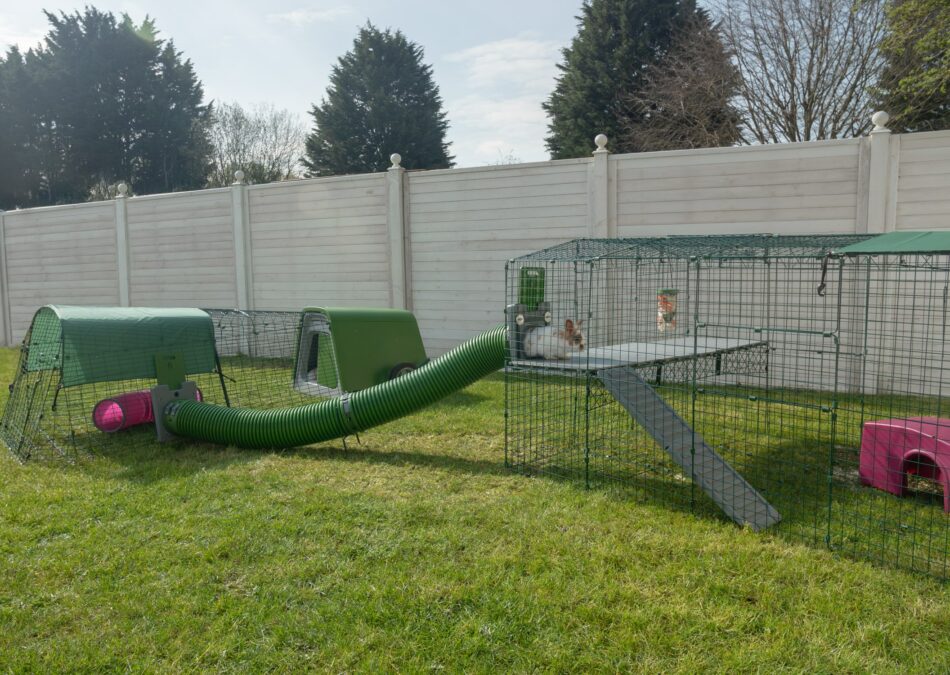
This entry was posted in Rabbits
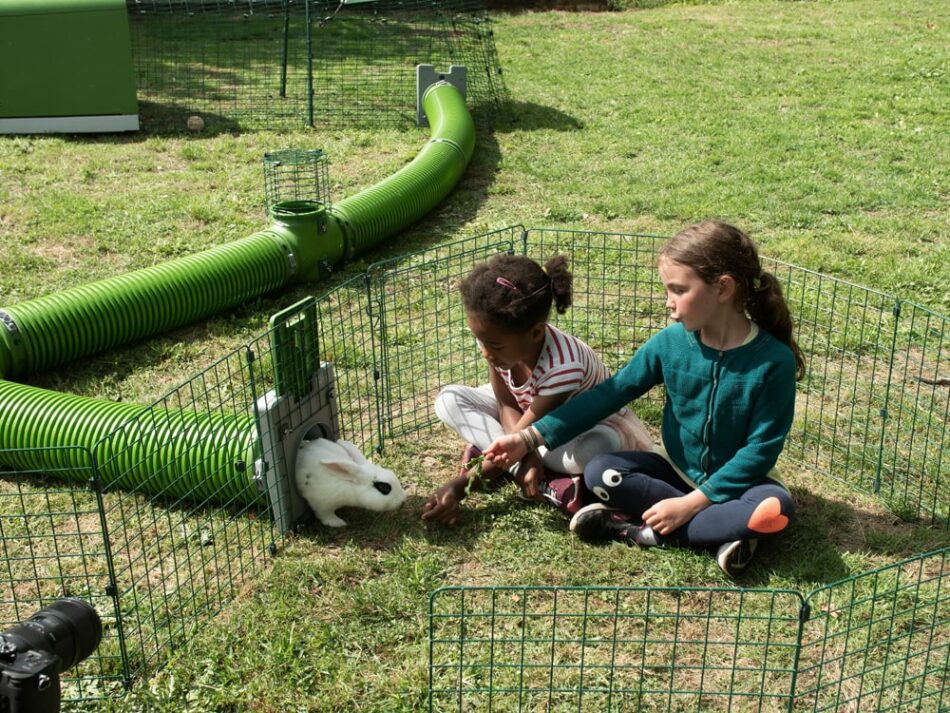 Did you know that you can raise an animal for your 4-H project? Not only that, but you can raise your 4-H project animal out in the country, or right in the middle of the city! With Omlet, raising a small animal for your 4-H project is easy and enjoyable.
Did you know that you can raise an animal for your 4-H project? Not only that, but you can raise your 4-H project animal out in the country, or right in the middle of the city! With Omlet, raising a small animal for your 4-H project is easy and enjoyable.
The National 4-H Council has many different opportunities for projects, and raising animals is part of most local 4-H groups. We’ll help you get started with your new 4-H project by helping you decide which animal would be the best fit for you. And, we’ll talk about how to care for your 4-H project animal, how to get ready for show day, and what to expect along the way.
What is 4-H?
4-H stands for: “head, heart, hands, and health.” These four aspects are what 4-H programs foster in kids ages 8-18 years old. From science, community outreach, agriculture, to healthy living programs, there’s something for everyone!
Projects for 4-H are chosen on an individual basis. These projects are completed over the course of several months, and are usually shown at an exhibition or county fair. If you’ve been to a county fair or stock show, you’ve probably seen 4-H exhibitors displaying their projects. Projects like art, leather working, welding, and livestock or small animals are commonly shown at these events.
Find your local 4-H group to see what types of projects your area supports. Most local 4-H groups will have animal projects as an option. Most animal projects are considered “livestock” under the category of agriculture, but many animals can be raised as a 4-H project. If you live in a city or are short on space, you may be particularly interested in small animals like rabbits, cavies (guinea pigs) or even chickens.
Choosing an animal for your 4-H project
Before deciding on your project, you’ll need to become a member of your local 4-H group and see which animal projects they support. Your group leader can help you choose the best animal for your project, and how and when to show them. Animal exhibitions usually take place at county fairs, stock shows, and group or association-sponsored shows. Show schedules are usually published well in advance, and can help you decide which animal you’d like to raise, and how soon you’ll need to get started.
Rabbits, guinea pigs, and chickens are great projects for children of all ages. They’re all easy to handle and care for, and come in a variety of breeds to choose from. These small animals don’t need much space, and can teach valuable animal husbandry skills to kids of all ages.
Raising your animals for your project is part of the work (and fun!) of being part of a 4-H group. Most animals need to be purchased as young as possible so that you have time to bond and fully raise your project. Rabbits, guinea pigs, and chickens all mature quickly,
Caring for your 4-H project animal
Whichever animal you choose for your 4-H project, they’ll need housing and proper care to thrive. It’s important to set up their housing and purchase their feed and accessories before bringing them home. We’ve outlined some basic care needs for rabbits, guinea pigs, and chickens to help you decide which animal project is the best fit for you.
Caring for rabbits
Taking care of a rabbit is a big responsibility, but with the right products can be easy and enjoyable. Bunnies bond with their owners, are fun to show, and there are a variety of rabbit breeds to choose from. To successfully keep a rabbit for your project, you’ll need:
It’s important that your rabbit has enough room to run and build muscle. Body composition is one of the criteria that your rabbit will be judged on, so keeping them fit is essential. Some breeds may also require mild to moderate grooming. All rabbits will need their nails trimmed routinely and given chew toys (preferably those made from apple wood) to help keep their continuously-growing teeth filed down. Handling your rabbit daily will help prepare them for their routine grooming sessions and for the show table.
Caring for guinea pigs
Taking care of guinea pigs is similar to caring for a rabbit. The exception is that while rabbits can thrive being kept by themselves, guinea pigs do best in pairs. To avoid unwanted litters, make sure to get two guinea pigs of the same gender! You may not necessarily show both of them, but it’s best to get your pair while they are young so that they can bond and mature together.
To care for guinea pigs, you’ll need:
Like rabbits, some guinea pig breeds will require grooming beyond regular nail trims. Handle your guinea pigs daily and help them get used to being placed on a table for showing. Omlet’s Guinea Pig Platforms are a great tool for getting your cavies used to being on a table-like surface.
Caring for chickens
Taking care of chickens is surprisingly easy once you understand their basic needs. Even though they’re commonly associated with farms, chickens can actually thrive in urban settings too. Since chickens aren’t common backyard pets in cities, make sure you check with your city zoning office to get permission to house chickens, and if there are housing requirements for your flock.
Chickens need:
There are many different breeds of chickens to choose from. If you choose laying hens to show, you’ll get to benefit from fresh eggs once they’re old enough to start laying. It’s important to remember that chickens are flock animals by nature, so you’ll want to keep a minimum of 2-3 birds at a time.
Breed-specific care
Each breed has their own standards by which they will be graded on by a judge. Their coat or feather coloring and patterns, body composition, conformation, overall health, and size will all be taken into account. It’s also important to choose your project animals from reputable breeders.
Some flaws in breed standards will be grounds for disqualification or score docking. While mixed breeds make excellent pets, only purebred animals are allowed to be shown. Once you’ve selected the breed of rabbit, guinea pig or chicken that you’d like to show, familiarize yourself with the breed standard so that you can select quality animals. You may want to ask your 4-H leader or other seasoned-show person to go with you when you pick out your young animal.
Preparing for your show
You’ll have your project animals for months before showing them, which gives you time to prepare both yourself and your animals for show day. Your 4-H group will likely have meetings that are held regularly to support you throughout your journey. Some meetings may require you to bring your animal along with you so that your leader can check their progress.
Rabbits, guinea pigs, and chickens will all be weighed on show day, so it’s important to weigh them at home to make sure they’re getting proper nutrition. Keep a record of each weighing session to share with your 4-H leader so that they can help you determine if your animals are over or underweight.
For the majority of the show, your rabbit, guinea pig, or chicken will be placed in a wire cage until it’s time for the judge to handle them. Practice having your animal stay in the same cage that you will use to transport them to the show a few times each week to get them used to being confined outside of their hutch and run.
When it’s your rabbit, guinea pig, or chicken’s turn, the judge will remove them from their wire cage and handle them. They will place them on a table, feel their muscles and fur or feathers, and look at their overall appearance. Ask your 4-H leader to help you with proper table placement and how to hold your animals the same way the judge will. A well-mannered, trained 4-H animal stands out to a judge!
What to expect after the show
You may have offers from potential buyers for your rabbit, guinea pig, or chicken after a show – especially if they’ve won a ribbon! It’s completely up to you if you’d like to sell your project animal, or if you’d like to continue on with their show career. Some people sell their animals at a show in order to try a different breed or type of animal for their next project. Others may decide that they want to keep their project animals as family pets, or as breeding stock for future projects.
If you don’t have offers for your animals at the show, that’s okay too. You can still decide to sell them later, or keep them as family pets. Take notes from the judge to review and see if the marks are something your animal can overcome through nutrition or exercise. If your animal was disqualified for not having breed-standard coloring or build, then they should be retired as a beloved family pet.
No matter the results, you should feel immense pride after completing your first show! Lots of time and effort goes into taking care of animals – whether they be show animals or family pets. Some of the great opportunities 4-H has to offer are teaching children responsibility, hard work, and dedication. And, sometimes not winning a ribbon is one of the greatest learning opportunities of all.
Omlet and your 4-H animal project
Omlet has housing solutions for your 4-H animal projects. By having easy-to-clean hutches and coops, you can keep your animals’ home clean and comfortable in minutes, saving you valuable time to train and work with your rabbit, guinea pigs, or chickens. Choose from our line of enriching products to build both your relationship with your 4-H project animals and their muscles:

This entry was posted in Chickens

What do you think of when you hear the word whisker? You may envision a 5 o’clock shadow on the face of a man, or maybe even a kitchen gadget. But chances are that the first thing that comes to mind is the face of an adorable animal such as a kitten or a rabbit.
We all know that rabbits have whiskers – as children, we learn to draw them onto the faces of our bunny artwork, and that they’re an essential part of any good rabbit costume. But do whiskers serve a practical purpose beyond just adding cute-factor to the muzzles they grace?
Virtually every mammal has whiskers! Whiskers have much more sensitive follicle bases than regular hairs, so while nerves do not run through the whisker itself, they are able to relay sensory input through touch. These naturally-acquired facial accessories serve the same two main functions in all species:
- To sense surroundings in dark conditions
- To serve as a measuring aid when assessing small spaces
So as a pet, does your rabbit still need these capabilities? And as an owner, is there any special care to be taken with these sensitive appendages?
The wonder of whiskers
Your pet rabbit uses their whiskers on a daily basis. In fact, they provide a virtual sixth-sense for your bunny! Rabbits don’t have the same focus or depth-perception to their vision that humans do, so their whiskers provide them with tactile sensory feedback to fill in the missing details. Even when they’re in a familiar space such as their rabbit hutch or rabbit playpen, rabbits utilize their facial “feelers” when it’s too dark to see their surroundings.
Before just bounding into any ol’ burrow, your rabbit uses its whiskers to determine whether or not they’ll fit into a tight space. Even as your rabbit runs through their Zippi Rabbit Tunnels, they’re being felt out by a rabbit’s whiskers to make sure they’ll fit!
And, new studies suggest that like other animals, rabbits are able to tell the texture of an object by vibrating their whiskers against it! Rabbits can also sense vibrations and the movement of air and water with their whiskers.
Rabbits are able to twitch and move their whiskers in an action called “whisking.” While this type of whisking may not produce baked goods, it does bring joy to the observer! Whiskers are also the first points of contact when meeting another rabbit or fellow animal with whiskers – almost like a handshake!
Whisker length and arrangement
A rabbit’s longest whiskers are as long as their bodies are wide on each side! They’re also arranged according to a specific pattern above their eyes, on their nose, and under their chins for a full range of spatial awareness. The whiskers start off shorter by their nose, and get longer in each row going toward their cheeks and tops of their heads.
The whiskers toward the front of their face act as tactile tools for feeling around in the dark, or for sensing objects directly in front of them. Due to the placement of their eyes, rabbits cannot see something that’s directly in front of their nose – they rely on their other senses to perceive what is right in front of them.
The longer whiskers above their eyes look very similar to false eyelashes! Not only does this give them a doe-eyed expression, these longer lashes also keep debris from getting into a rabbit’s eyes.
A rabbit’s longest whiskers are used primarily for gauging spaces, orienting themselves, and feeling for vibrations.
Does my rabbit need a shave?
It’s very important to never cut your rabbit’s whiskers! Since the whisker itself does not have blood or nerve supply, cutting it will not cause pain, but it will interfere with a rabbit’s natural abilities and coordination. Think of it as if you were taking eyeglasses or contact lenses away from someone who is severely near-sighted. They would be able to walk, certainly, but they would stumble, bump into things, second-guess themselves and not move nearly as quickly or efficiently as they did before. If a rabbit were to suddenly lose its whiskers, it would have to re-learn how to interact with its surroundings.
If you were to trim rather than shave the whiskers off at the base, it would relay incorrect information to the rabbit. By trimming the whiskers shorter, they would no longer be as long as the rabbit is wide. Your rabbit may then try to squeeze into spaces they have no business trying to fit into!
Whisker worries
Why are my rabbit’s whiskers falling out?
Just as they do with their coats, rabbits will shed their whiskers in a routine fashion. So, if you find a stray whisker in your rabbit’s environment every once in a while – don’t be alarmed! It’s a perfectly normal process, and soon a new whisker will grow in its place.
Will your rabbit be alright without a whisker? Don’t fret – if your rabbit is down a whisker or two, they likely won’t notice the difference!
What if my rabbit’s whisker is bent?
A bent whisker will either eventually fall off at the break, or fall out as part of the natural shedding process and will regrow as usual. Refrain from trimming the broken part of the whisker yourself because you could accidentally cut or more whiskers in the process!
Why is my rabbit bleeding from the base of a whisker?
If a whisker is pulled or twisted during rough play, it may either fall out completely, or be partially detached at the base. Whiskers are as sensitive as they are because the roots are in a hair follicle with a blood supply. A small amount of blood is normal for the sudden, unexpected removal or loss of a whisker, but if your bunny is bleeding actively, call your veterinarian! Other reasons for concern over a whisker that warrant a call to the veterinarian include:
- Inflamed base of a whisker, with or without swelling
- Oozing blood or yellow fluid from the base of a whisker
- A partially detached whisker that has not fallen out on its own after a couple of days
- Whisker loss beyond normal shedding – this could be losing multiple whiskers all at once, or whiskers not growing back
- Whiskers above the eye that turn inward, causing them to rub against your rabbit’s cornea
Create spatial awareness
Even with the use of super-appendages, rabbits need a space designed to foster and encourage their natural behaviors. Rabbits are very sensitive animals, and their whisker-wielding ways only adds to the amount of stimuli they process.
By providing the optimal environment, you’ll create a space for your rabbits to feel safe when they perceive danger, playful when they feel safe, and relaxed when they feel secure. Our line of rabbit products do exactly that, taking the guesswork out of creating the ideal habitat for your rabbit!
Our products have been thoroughly “whisked” over by hundreds (maybe even thousands!) of rabbits from around the world. And all of the whiskers agree – Omlet has the hutches, play tunnels, shelters, and accessories to keep your rabbit’s sixth sense performing its best.

This entry was posted in Rabbits

Christmas is the most magical part of the season. It’s the perfect time to snuggle up with your small furry friend and enjoy this special time of year.
And let’s not forget the food. Christmas is one of the biggest holidays for a “foodie,” and if you share a home with a rabbit or guinea pig, you know they’re foodies too. Thankfully, there are several festive treats that you can share with your food-loving friends – just hold the seasoning and spices.
What are your Christmas meal staples? If you’re like most, your Christmas spread probably includes turkey, stuffing, various vegetables, and sides, punctuated with decadent desserts. And with all that meal prep, there are lots of scraps and trimmings that you can give your rabbit or guinea pig as a special holiday treat.
Treats for your bunnies
Rabbits and carrots go together like turkey and gravy. But what other trimmings can you save for your bunny when you’re prepping for your Christmas meal?
Rabbit-safe Christmas meal ingredients that you can share with your bunny include: carrots and their tops (though in moderation, as carrots are high in sugar – which is why rabbits love them), celery, cranberries (fresh or unsweetened and dried), fresh green beans, and leafy greens such as lettuce and cabbage. And if your Christmas dinner doesn’t stick to the traditional menu, a list of rabbit-safe foods can be referenced to see what you can feed your bunny from the kitchen.
The easiest way to keep your rabbit’s treats separate from what gets tossed and what gets seasoned is to keep a bunny bowl on the counter. Any trimmings that are meant for your rabbit can be scooped into a bowl and offered once you’re done with your meal prepping – just make sure all of your helping hands in the kitchen know what this is for.
If you’re really feeling festive, you can also find many recipes online for rabbit-friendly baked goods like carrot cake or banana treats to make their holiday extra special.
Guinea pig goodies
Guinea pigs follow a diet that resembles a rabbit’s, except that they need more vitamin C as they cannot manufacture their own. The same foods that you reserve for your rabbit can be safely offered to your guinea pig, but some additional considerations for cavies are: small amounts of orange or orange peel, bell peppers (yellow, red, or orange are best), broccoli, apple slices, and berries.
Part of the cuteness of cavies is their build, but with their little legs and larger bodies, it’s important not to overfeed them. Ideas for guinea pig baked goods can also be found online, but any holiday goodies should be served as a one-time treat.
Keep a cavy cup handy in the kitchen during holiday baking and meal prep. If possible, refrigerate excess scraps to offer at a later date if your cup “runneth over!”
Holiday hazards
While there are many delicious and nutritious foods to share with your rabbit or guinea pig, there are also holiday staples that should not be shared. Avoid feeding:
- Nuts and seeds
- Potatoes (especially if raw)
- Sugary or baked goods
- Bread
- Meat
If your rabbit or guinea pig happens to sneak a taste of something they shouldn’t, identify what it was and how much they ingested and call your vet. Christmas is the most common time of the year for pets (large and small) to get into something they shouldn’t, so take precautions to ensure your bunny or cavy aren’t able to sneak a bite. Make sure your rabbit or guinea pig is safe in their hutch or run, or set up a rabbit or guinea pig playpen to keep your furry family members out of the kitchen and away from falling foods and cooking utensils.

Special occasion treats and year-round feeding
Rabbits and guinea pigs both need a quality pellet feed (ideally timothy hay-based), and unlimited access to timothy hay or orchard grass and fresh water, with guinea pigs needing additional vitamin C. Around 90% of both your rabbit and guinea pig’s diet should consist of these staples, with treats being given no more than a few times a week.
The best treats are those that incorporate into a well-balanced diet for bunnies and cavies, such as vegetables or fruits that offer nutritional value. Anything indulgent should be offered on special occasions like holidays or your pet’s birthday – otherwise, it might upset their digestive systems or influence their food preferences.
Feeding treats in a Caddi rabbit treat holder or a Caddi guinea pig treat holder is a great way to keep their favorite treats together and up off the ground. It’s also a nice “plating” option when serving up special holiday fare.
A home for the holidays
The holiday season should be a time of comfort and joy for both you and your furry family members. This time of the year also brings colder temperatures and freezing precipitation, so be sure your rabbit or guinea pig is housed in an insulated rabbit hutch or guinea pig hutch for optimum cosiness. And bring on the joy with Zippi tunnels and playpens for endless fun so guinea pigs and rabbits can warm up their bodies and appetites.
With a warm home, full bellies, and loving humans, your small furry family members are sure to have the best holiday season.

This entry was posted in Guinea Pigs

Are you considering adding a rabbit to your family? Or thinking about bringing an outdoor bunny indoor for a season, or even permanently?
Like other small pets, rabbits are very interesting companions to share a home with. They’re easy to care for, build bonds with their families, and don’t require a large amount of space. But unlike other small pets, rabbits are highly adaptable when it comes to their lodging. They can be housed indoors or outdoors, and adapt quickly to a wide variety of environments.
Keeping rabbits indoors allows for closer interaction with them, and also eliminates certain risk factors that come along with outdoor living – such as predators and harsh weather. By keeping your rabbit inside, you’ll also be able to observe their personality and behaviors much more closely. By sharing your living space with your bunny, you won’t have to miss out on a single binky, flop, sprawl, or purr from your furry-family member!
As with any pet, you’ll need to maintain your bunny’s abode to keep it smelling and looking fresh. But with proper placement and cleaning measures, having a pet rabbit indoors can be an aesthetically pleasing and enriching addition to your home!
Boundaries for your bunny
Like small children, bunnies are very curious and don’t always know what’s friend or foe before testing it! It’s very important to take the following rabbit-proofing measures before allowing your bun to explore the inside of your home:
- Make sure your rabbit does not have access to electrical wires such as electronic cables, lamp cords, etc.
- Close off any small spaces that your bunny may try to squeeze into.
- Let everyone in your home know when your rabbit has run of the house to make sure no outside doors get left open.
- Consider blocking off access to wooden furniture that may be enticing to chew on, as treated wood is harmful to rabbits.
For a more exhaustive list of indoor rabbit-proofing, visit: How to Rabbit-Proof Your House.
While you should aim to give your rabbit as much room to stretch their legs outside of their hutch as possible, it’s a good idea to limit your rabbit to specific areas of your home to explore, such as one room or in a rabbit playpen. You’ll be able to keep up with your bunny much easier than if they had free-rein of your house, and having boundaries will make them feel safe and secure.
Litter boxes are not just for cats
Did you know that you can litter box train your rabbit? Like cats, rabbits can be taught to utilize a litter box when nature calls!
Rabbits don’t have quite the instinctive drive to use a litter box as their feline friends, but with a little practice and patience they’ll get the hang of it.
Basic litter box training for rabbits:
- Placement is key! Find where your bunny likes to relieve themselves (usually a corner or other secluded spot) and place their litter box in the exact same location.
- Use some of your rabbit’s eliminations to “bait” the litter box. Pick up some of your bunny’s droppings and empty them on top of the litter. You can also mop up some urine with an unscented tissue or paper towel to place in the litter box.
- Choose a litter box or pan that is an appropriate size for your bunny. If your rabbit uses a corner as their toilet, consider buying a corner-mounted litter box.
- Use a rabbit-appropriate litter (not cat litter!) for your bunny’s litter box.
- Keep your bunny’s litter box in close proximity for the first few weeks. After they get the hang of using it, you can move it to a specific room or keep it in their hutch for them to scurry off to when nature calls!
Be patient when training your rabbit to use a litter box, and expect accidents to happen! For more information on litter box training your rabbit, check out: How to Litter Train Your Rabbit.
When and how often to clean your rabbit’s home
Even if your rabbit is litter box trained, their enclosure will need to be cleaned regularly. Many factors determine how often your bunny’s home needs to be refreshed. Male or female, spayed or neutered, and the size of their enclosure all play a part in how often bedding and hutches will need to be cleaned.
A male rabbit that has not been neutered will have a natural “musky” smell, both from his scent glands and in his urine. Intact male rabbits are also more likely to spray to mark their territory, making eliminations outside of their litter box a regular occurrence (high-sided or enclosed litter boxes are ideal for male rabbits!). Intact females are also known to mark with urine more so than spayed females. However, thanks to their anatomical differences from males, they aren’t quite as messy with their marking!
Use an unscented bedding for your rabbit’s enclosure and litter. While it may sound nice to have a scented bunny enclosure, many added perfumes or scents can be irritating to a rabbit’s sensitive sniffer! Stick with natural odor-absorbing beddings such as recycled paper, pine shavings or pellets, or aspen shavings. Avoid using any bedding that is made from cedar, as the oils can be toxic to your bunny. Straw makes for interesting bedding, but will mold easily once it’s wet, resulting in more frequent changes.
Plastic rabbit hutches are much easier to keep clean than their wooden counterparts, as they do not absorb odors. They’ll also last longer since rabbits nibble on wood to trim their ever-growing teeth! Hutches such as the Eglu Go Rabbit Hutch offer ample ventilation to help air out any stale odors and allow for faster drying times after cleaning.
Rabbit-friendly cleaners
There are many commercially available rabbit-friendly cleaners and sprays that can be used safely around your bunny – just be sure to check the labels for use around rabbits specifically. Sprays formulated with enzymes are great for a quick refresh in the room your rabbit is housed in or in between cleanings – particularly if you have a male rabbit! Simply spray on your bunny’s bedding, litter, or hutch to neutralize odors for up to 24 hours. Again, just be sure to adhere to the manufacturer’s instructions on the bottle!
A quick and easy DIY cleaning solution can be made by mixing equal parts vinegar and warm water for your rabbit’s hutch and accessories. Vinegar is one of the safest and effective cleaning agents for use around bunnies, but if you don’t like the smell of vinegar, this mixture can be diluted even further – up to 1 part vinegar to 10 parts water while still maintaining its cleaning ability. Refrain from adding any “smelly” agents such as essential oils, scent boosters, or other extras to your homemade cleaning solution.
Cleaners to avoid around your bunny
A common additive to cat litter boxes for odor-elimination is baking soda, but it is one of the substances that is toxic to bunnies in large amounts.
Other harmful cleaners or odor-eliminating substances that are hazardous to rabbits include:
- Aerosols, or air fresheners
- Chlorine bleach or ammonia
- Detergents or dishwashing liquid
- Powdered cleaning chemicals
- Floor cleaners, both for hard flooring and carpets
- Wood furniture cleaners and conditioners
It’s important to keep any areas your rabbit may explore free of these substances, including any rooms of your home that they will have access to. Bunnies may try to dig or nibble on carpets, baseboards, or furniture legs, so be sure to either keep them away from these objects, or to only clean your home with rabbit-safe options.
As always, if you suspect your rabbit has ingested or come into contact with a harmful substance, contact your veterinarian right away.
Your rabbit and us
At Omlet, we strive to help you reduce time cleaning and maintaining your rabbit’s area so there’s more time for play! With our extensive line of rabbit products, you’ll find everything you need to make indoor-rabbit ownership easy and enjoyable. Zippi rabbit runs, playpens, and tunnels allow you to customize the ultimate indoor rabbit playground, with plenty of space for them to “binky”, zoom, sprawl, and hop to their heart’s content! Our products are fully customizable to your space and preferences, and can be modified as often as you’d like to keep your rabbit’s space engaging and enriching.
Whether you’re bringing your rabbit indoors for the season, or making a more permanent housing change, we’re here to help! Have questions about transitioning your outdoor rabbit indoors or about products that will help your rabbit adjust to life indoors? Message us below!

This entry was posted in Rabbits
















































